Security Challenges in IoT Health Care
VerifiedAdded on 2023/06/12
|18
|7127
|60
AI Summary
This paper discusses the security challenges in the IoT health care industry and proposes mitigation plans to resolve them. It covers the advantages and disadvantages of IoT in health care, and the future scope of research. The paper also includes a literature review, research questions, and a problem statement.
Contribute Materials
Your contribution can guide someone’s learning journey. Share your
documents today.
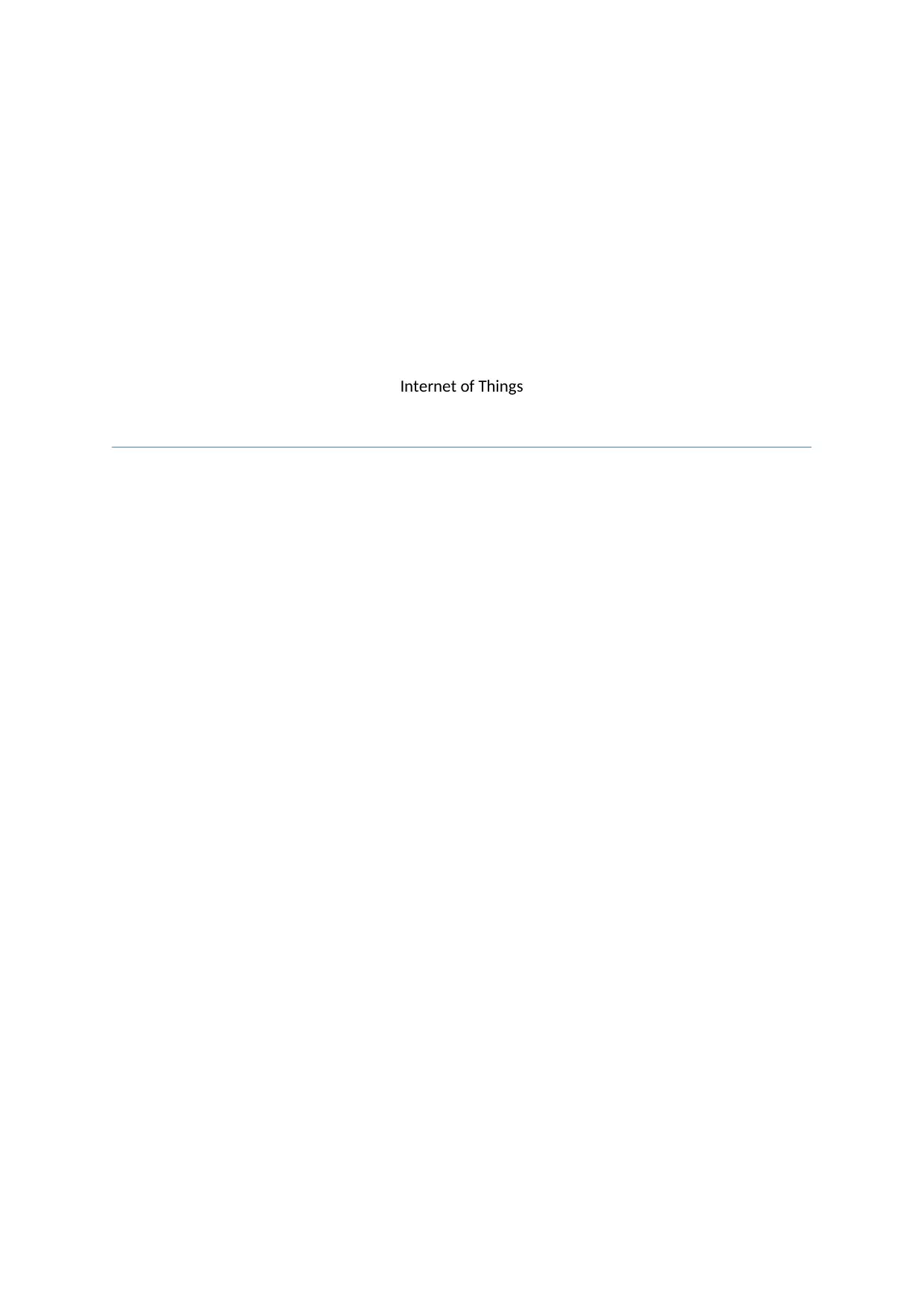
Internet of Things
Secure Best Marks with AI Grader
Need help grading? Try our AI Grader for instant feedback on your assignments.
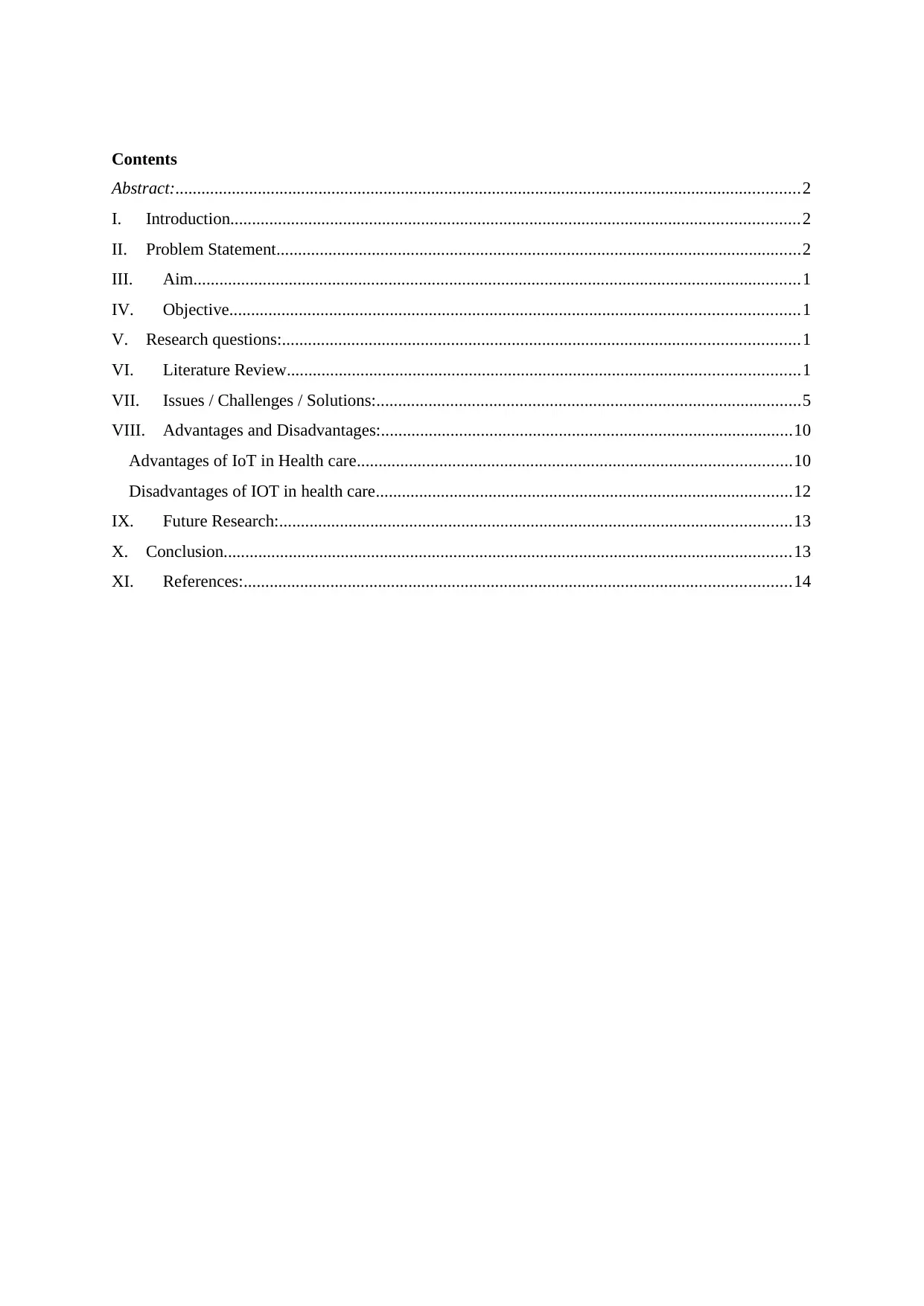
Contents
Abstract:................................................................................................................................................2
I. Introduction...................................................................................................................................2
II. Problem Statement.........................................................................................................................2
III. Aim............................................................................................................................................1
IV. Objective...................................................................................................................................1
V. Research questions:.......................................................................................................................1
VI. Literature Review......................................................................................................................1
VII. Issues / Challenges / Solutions:..................................................................................................5
VIII. Advantages and Disadvantages:...............................................................................................10
Advantages of IoT in Health care....................................................................................................10
Disadvantages of IOT in health care................................................................................................12
IX. Future Research:......................................................................................................................13
X. Conclusion...................................................................................................................................13
XI. References:..............................................................................................................................14
Abstract:................................................................................................................................................2
I. Introduction...................................................................................................................................2
II. Problem Statement.........................................................................................................................2
III. Aim............................................................................................................................................1
IV. Objective...................................................................................................................................1
V. Research questions:.......................................................................................................................1
VI. Literature Review......................................................................................................................1
VII. Issues / Challenges / Solutions:..................................................................................................5
VIII. Advantages and Disadvantages:...............................................................................................10
Advantages of IoT in Health care....................................................................................................10
Disadvantages of IOT in health care................................................................................................12
IX. Future Research:......................................................................................................................13
X. Conclusion...................................................................................................................................13
XI. References:..............................................................................................................................14
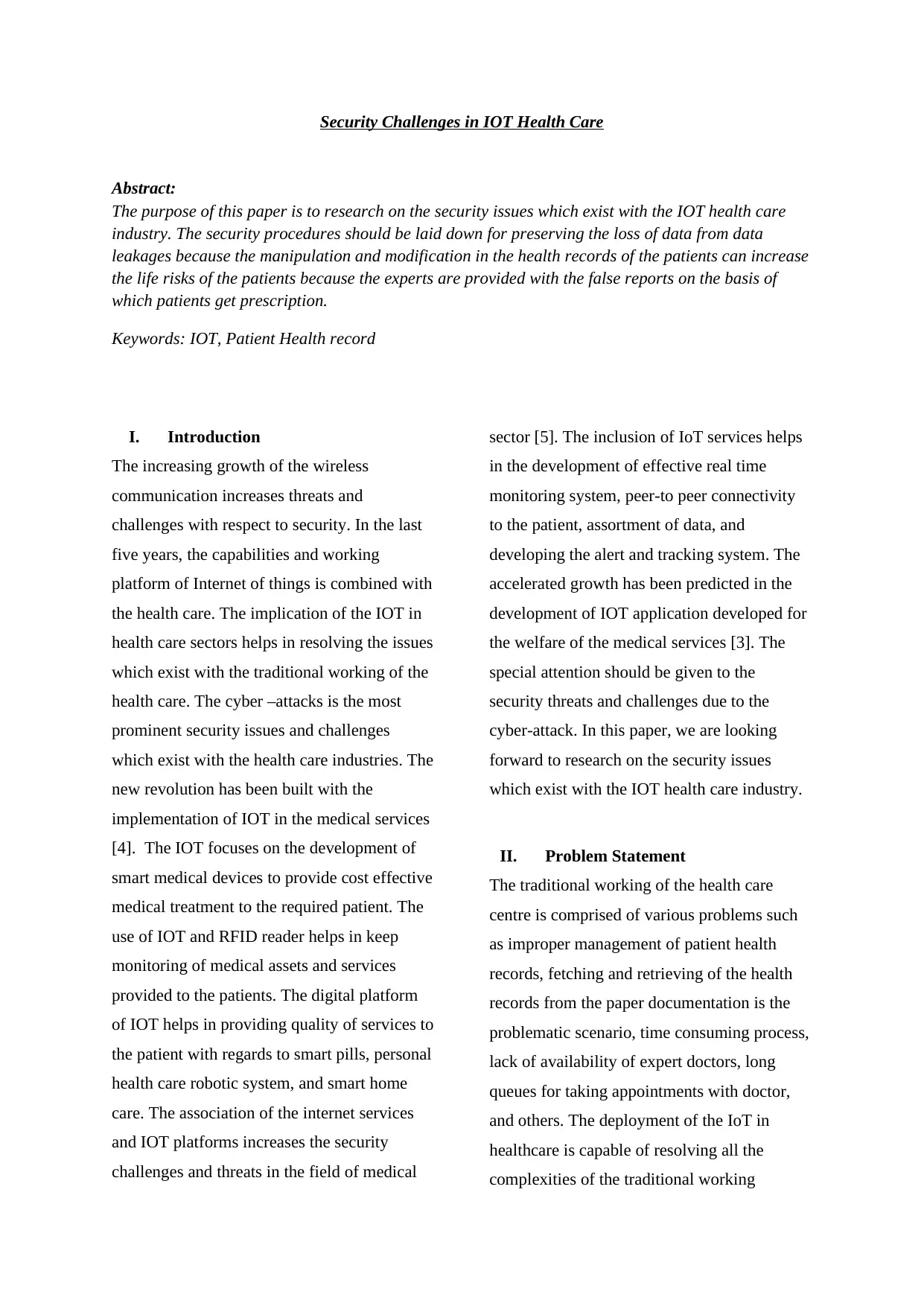
Security Challenges in IOT Health Care
Abstract:
The purpose of this paper is to research on the security issues which exist with the IOT health care
industry. The security procedures should be laid down for preserving the loss of data from data
leakages because the manipulation and modification in the health records of the patients can increase
the life risks of the patients because the experts are provided with the false reports on the basis of
which patients get prescription.
Keywords: IOT, Patient Health record
I. Introduction
The increasing growth of the wireless
communication increases threats and
challenges with respect to security. In the last
five years, the capabilities and working
platform of Internet of things is combined with
the health care. The implication of the IOT in
health care sectors helps in resolving the issues
which exist with the traditional working of the
health care. The cyber –attacks is the most
prominent security issues and challenges
which exist with the health care industries. The
new revolution has been built with the
implementation of IOT in the medical services
[4]. The IOT focuses on the development of
smart medical devices to provide cost effective
medical treatment to the required patient. The
use of IOT and RFID reader helps in keep
monitoring of medical assets and services
provided to the patients. The digital platform
of IOT helps in providing quality of services to
the patient with regards to smart pills, personal
health care robotic system, and smart home
care. The association of the internet services
and IOT platforms increases the security
challenges and threats in the field of medical
sector [5]. The inclusion of IoT services helps
in the development of effective real time
monitoring system, peer-to peer connectivity
to the patient, assortment of data, and
developing the alert and tracking system. The
accelerated growth has been predicted in the
development of IOT application developed for
the welfare of the medical services [3]. The
special attention should be given to the
security threats and challenges due to the
cyber-attack. In this paper, we are looking
forward to research on the security issues
which exist with the IOT health care industry.
II. Problem Statement
The traditional working of the health care
centre is comprised of various problems such
as improper management of patient health
records, fetching and retrieving of the health
records from the paper documentation is the
problematic scenario, time consuming process,
lack of availability of expert doctors, long
queues for taking appointments with doctor,
and others. The deployment of the IoT in
healthcare is capable of resolving all the
complexities of the traditional working
Abstract:
The purpose of this paper is to research on the security issues which exist with the IOT health care
industry. The security procedures should be laid down for preserving the loss of data from data
leakages because the manipulation and modification in the health records of the patients can increase
the life risks of the patients because the experts are provided with the false reports on the basis of
which patients get prescription.
Keywords: IOT, Patient Health record
I. Introduction
The increasing growth of the wireless
communication increases threats and
challenges with respect to security. In the last
five years, the capabilities and working
platform of Internet of things is combined with
the health care. The implication of the IOT in
health care sectors helps in resolving the issues
which exist with the traditional working of the
health care. The cyber –attacks is the most
prominent security issues and challenges
which exist with the health care industries. The
new revolution has been built with the
implementation of IOT in the medical services
[4]. The IOT focuses on the development of
smart medical devices to provide cost effective
medical treatment to the required patient. The
use of IOT and RFID reader helps in keep
monitoring of medical assets and services
provided to the patients. The digital platform
of IOT helps in providing quality of services to
the patient with regards to smart pills, personal
health care robotic system, and smart home
care. The association of the internet services
and IOT platforms increases the security
challenges and threats in the field of medical
sector [5]. The inclusion of IoT services helps
in the development of effective real time
monitoring system, peer-to peer connectivity
to the patient, assortment of data, and
developing the alert and tracking system. The
accelerated growth has been predicted in the
development of IOT application developed for
the welfare of the medical services [3]. The
special attention should be given to the
security threats and challenges due to the
cyber-attack. In this paper, we are looking
forward to research on the security issues
which exist with the IOT health care industry.
II. Problem Statement
The traditional working of the health care
centre is comprised of various problems such
as improper management of patient health
records, fetching and retrieving of the health
records from the paper documentation is the
problematic scenario, time consuming process,
lack of availability of expert doctors, long
queues for taking appointments with doctor,
and others. The deployment of the IoT in
healthcare is capable of resolving all the
complexities of the traditional working
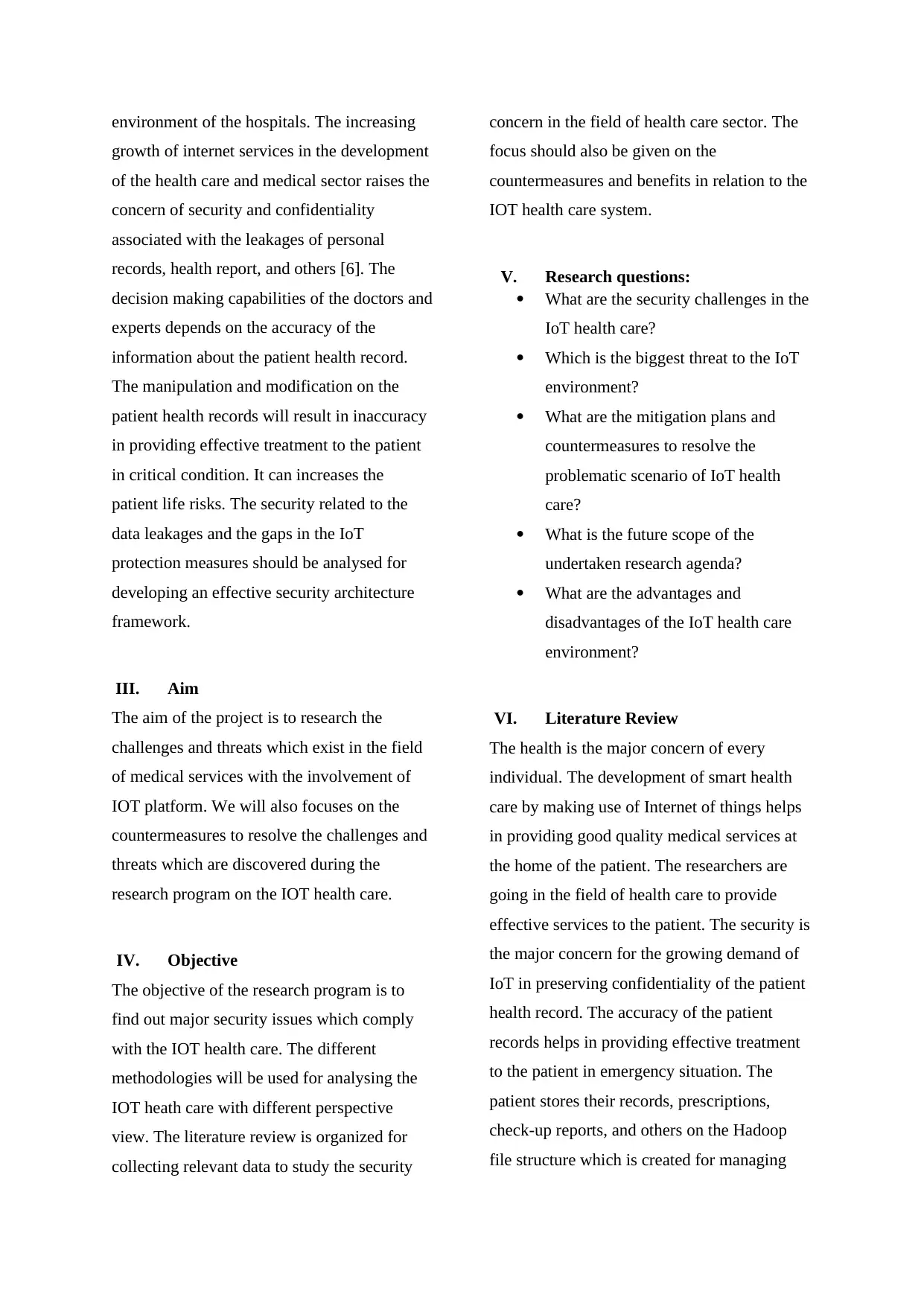
environment of the hospitals. The increasing
growth of internet services in the development
of the health care and medical sector raises the
concern of security and confidentiality
associated with the leakages of personal
records, health report, and others [6]. The
decision making capabilities of the doctors and
experts depends on the accuracy of the
information about the patient health record.
The manipulation and modification on the
patient health records will result in inaccuracy
in providing effective treatment to the patient
in critical condition. It can increases the
patient life risks. The security related to the
data leakages and the gaps in the IoT
protection measures should be analysed for
developing an effective security architecture
framework.
III. Aim
The aim of the project is to research the
challenges and threats which exist in the field
of medical services with the involvement of
IOT platform. We will also focuses on the
countermeasures to resolve the challenges and
threats which are discovered during the
research program on the IOT health care.
IV. Objective
The objective of the research program is to
find out major security issues which comply
with the IOT health care. The different
methodologies will be used for analysing the
IOT heath care with different perspective
view. The literature review is organized for
collecting relevant data to study the security
concern in the field of health care sector. The
focus should also be given on the
countermeasures and benefits in relation to the
IOT health care system.
V. Research questions:
What are the security challenges in the
IoT health care?
Which is the biggest threat to the IoT
environment?
What are the mitigation plans and
countermeasures to resolve the
problematic scenario of IoT health
care?
What is the future scope of the
undertaken research agenda?
What are the advantages and
disadvantages of the IoT health care
environment?
VI. Literature Review
The health is the major concern of every
individual. The development of smart health
care by making use of Internet of things helps
in providing good quality medical services at
the home of the patient. The researchers are
going in the field of health care to provide
effective services to the patient. The security is
the major concern for the growing demand of
IoT in preserving confidentiality of the patient
health record. The accuracy of the patient
records helps in providing effective treatment
to the patient in emergency situation. The
patient stores their records, prescriptions,
check-up reports, and others on the Hadoop
file structure which is created for managing
growth of internet services in the development
of the health care and medical sector raises the
concern of security and confidentiality
associated with the leakages of personal
records, health report, and others [6]. The
decision making capabilities of the doctors and
experts depends on the accuracy of the
information about the patient health record.
The manipulation and modification on the
patient health records will result in inaccuracy
in providing effective treatment to the patient
in critical condition. It can increases the
patient life risks. The security related to the
data leakages and the gaps in the IoT
protection measures should be analysed for
developing an effective security architecture
framework.
III. Aim
The aim of the project is to research the
challenges and threats which exist in the field
of medical services with the involvement of
IOT platform. We will also focuses on the
countermeasures to resolve the challenges and
threats which are discovered during the
research program on the IOT health care.
IV. Objective
The objective of the research program is to
find out major security issues which comply
with the IOT health care. The different
methodologies will be used for analysing the
IOT heath care with different perspective
view. The literature review is organized for
collecting relevant data to study the security
concern in the field of health care sector. The
focus should also be given on the
countermeasures and benefits in relation to the
IOT health care system.
V. Research questions:
What are the security challenges in the
IoT health care?
Which is the biggest threat to the IoT
environment?
What are the mitigation plans and
countermeasures to resolve the
problematic scenario of IoT health
care?
What is the future scope of the
undertaken research agenda?
What are the advantages and
disadvantages of the IoT health care
environment?
VI. Literature Review
The health is the major concern of every
individual. The development of smart health
care by making use of Internet of things helps
in providing good quality medical services at
the home of the patient. The researchers are
going in the field of health care to provide
effective services to the patient. The security is
the major concern for the growing demand of
IoT in preserving confidentiality of the patient
health record. The accuracy of the patient
records helps in providing effective treatment
to the patient in emergency situation. The
patient stores their records, prescriptions,
check-up reports, and others on the Hadoop
file structure which is created for managing
Secure Best Marks with AI Grader
Need help grading? Try our AI Grader for instant feedback on your assignments.
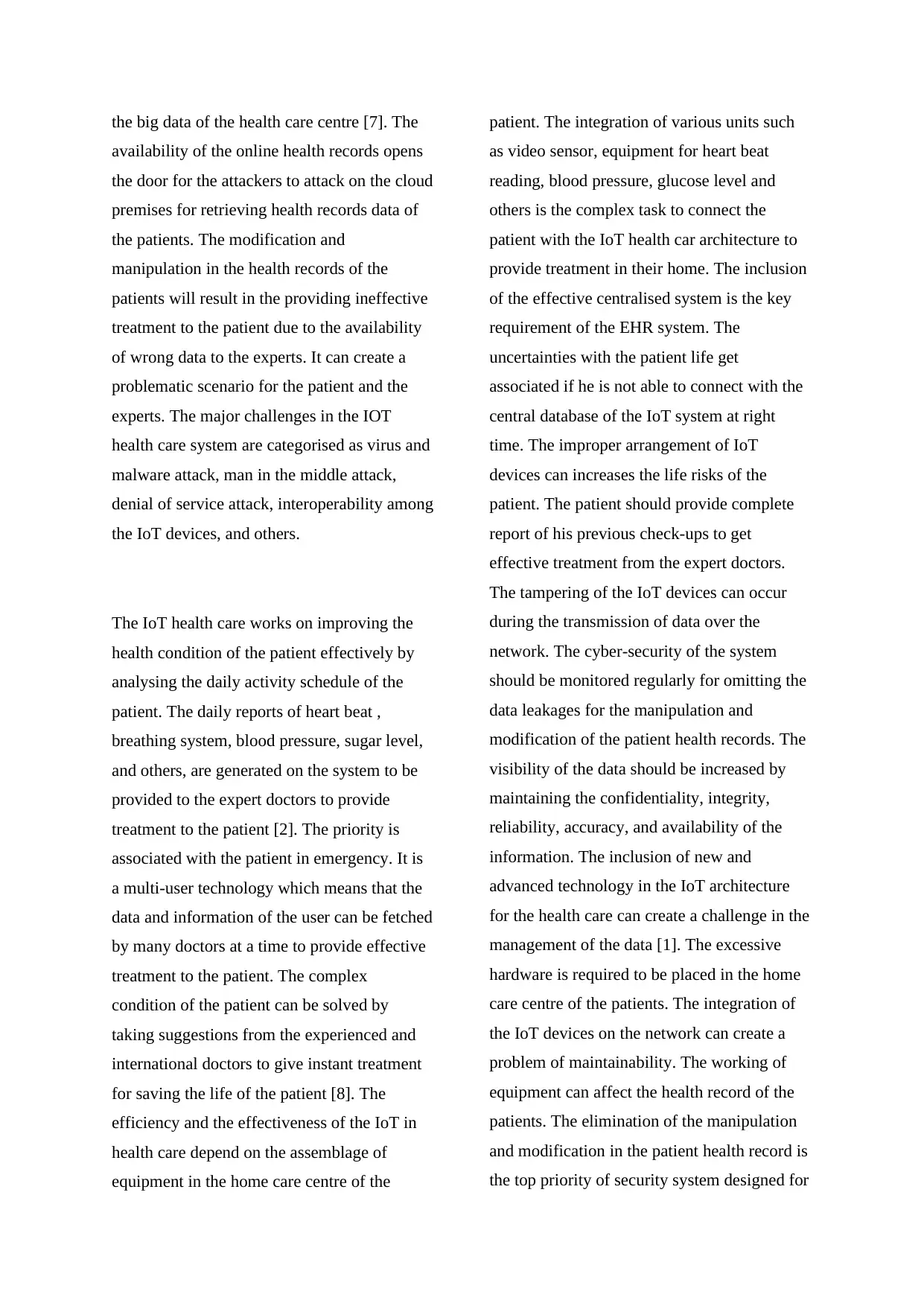
the big data of the health care centre [7]. The
availability of the online health records opens
the door for the attackers to attack on the cloud
premises for retrieving health records data of
the patients. The modification and
manipulation in the health records of the
patients will result in the providing ineffective
treatment to the patient due to the availability
of wrong data to the experts. It can create a
problematic scenario for the patient and the
experts. The major challenges in the IOT
health care system are categorised as virus and
malware attack, man in the middle attack,
denial of service attack, interoperability among
the IoT devices, and others.
The IoT health care works on improving the
health condition of the patient effectively by
analysing the daily activity schedule of the
patient. The daily reports of heart beat ,
breathing system, blood pressure, sugar level,
and others, are generated on the system to be
provided to the expert doctors to provide
treatment to the patient [2]. The priority is
associated with the patient in emergency. It is
a multi-user technology which means that the
data and information of the user can be fetched
by many doctors at a time to provide effective
treatment to the patient. The complex
condition of the patient can be solved by
taking suggestions from the experienced and
international doctors to give instant treatment
for saving the life of the patient [8]. The
efficiency and the effectiveness of the IoT in
health care depend on the assemblage of
equipment in the home care centre of the
patient. The integration of various units such
as video sensor, equipment for heart beat
reading, blood pressure, glucose level and
others is the complex task to connect the
patient with the IoT health car architecture to
provide treatment in their home. The inclusion
of the effective centralised system is the key
requirement of the EHR system. The
uncertainties with the patient life get
associated if he is not able to connect with the
central database of the IoT system at right
time. The improper arrangement of IoT
devices can increases the life risks of the
patient. The patient should provide complete
report of his previous check-ups to get
effective treatment from the expert doctors.
The tampering of the IoT devices can occur
during the transmission of data over the
network. The cyber-security of the system
should be monitored regularly for omitting the
data leakages for the manipulation and
modification of the patient health records. The
visibility of the data should be increased by
maintaining the confidentiality, integrity,
reliability, accuracy, and availability of the
information. The inclusion of new and
advanced technology in the IoT architecture
for the health care can create a challenge in the
management of the data [1]. The excessive
hardware is required to be placed in the home
care centre of the patients. The integration of
the IoT devices on the network can create a
problem of maintainability. The working of
equipment can affect the health record of the
patients. The elimination of the manipulation
and modification in the patient health record is
the top priority of security system designed for
availability of the online health records opens
the door for the attackers to attack on the cloud
premises for retrieving health records data of
the patients. The modification and
manipulation in the health records of the
patients will result in the providing ineffective
treatment to the patient due to the availability
of wrong data to the experts. It can create a
problematic scenario for the patient and the
experts. The major challenges in the IOT
health care system are categorised as virus and
malware attack, man in the middle attack,
denial of service attack, interoperability among
the IoT devices, and others.
The IoT health care works on improving the
health condition of the patient effectively by
analysing the daily activity schedule of the
patient. The daily reports of heart beat ,
breathing system, blood pressure, sugar level,
and others, are generated on the system to be
provided to the expert doctors to provide
treatment to the patient [2]. The priority is
associated with the patient in emergency. It is
a multi-user technology which means that the
data and information of the user can be fetched
by many doctors at a time to provide effective
treatment to the patient. The complex
condition of the patient can be solved by
taking suggestions from the experienced and
international doctors to give instant treatment
for saving the life of the patient [8]. The
efficiency and the effectiveness of the IoT in
health care depend on the assemblage of
equipment in the home care centre of the
patient. The integration of various units such
as video sensor, equipment for heart beat
reading, blood pressure, glucose level and
others is the complex task to connect the
patient with the IoT health car architecture to
provide treatment in their home. The inclusion
of the effective centralised system is the key
requirement of the EHR system. The
uncertainties with the patient life get
associated if he is not able to connect with the
central database of the IoT system at right
time. The improper arrangement of IoT
devices can increases the life risks of the
patient. The patient should provide complete
report of his previous check-ups to get
effective treatment from the expert doctors.
The tampering of the IoT devices can occur
during the transmission of data over the
network. The cyber-security of the system
should be monitored regularly for omitting the
data leakages for the manipulation and
modification of the patient health records. The
visibility of the data should be increased by
maintaining the confidentiality, integrity,
reliability, accuracy, and availability of the
information. The inclusion of new and
advanced technology in the IoT architecture
for the health care can create a challenge in the
management of the data [1]. The excessive
hardware is required to be placed in the home
care centre of the patients. The integration of
the IoT devices on the network can create a
problem of maintainability. The working of
equipment can affect the health record of the
patients. The elimination of the manipulation
and modification in the patient health record is
the top priority of security system designed for
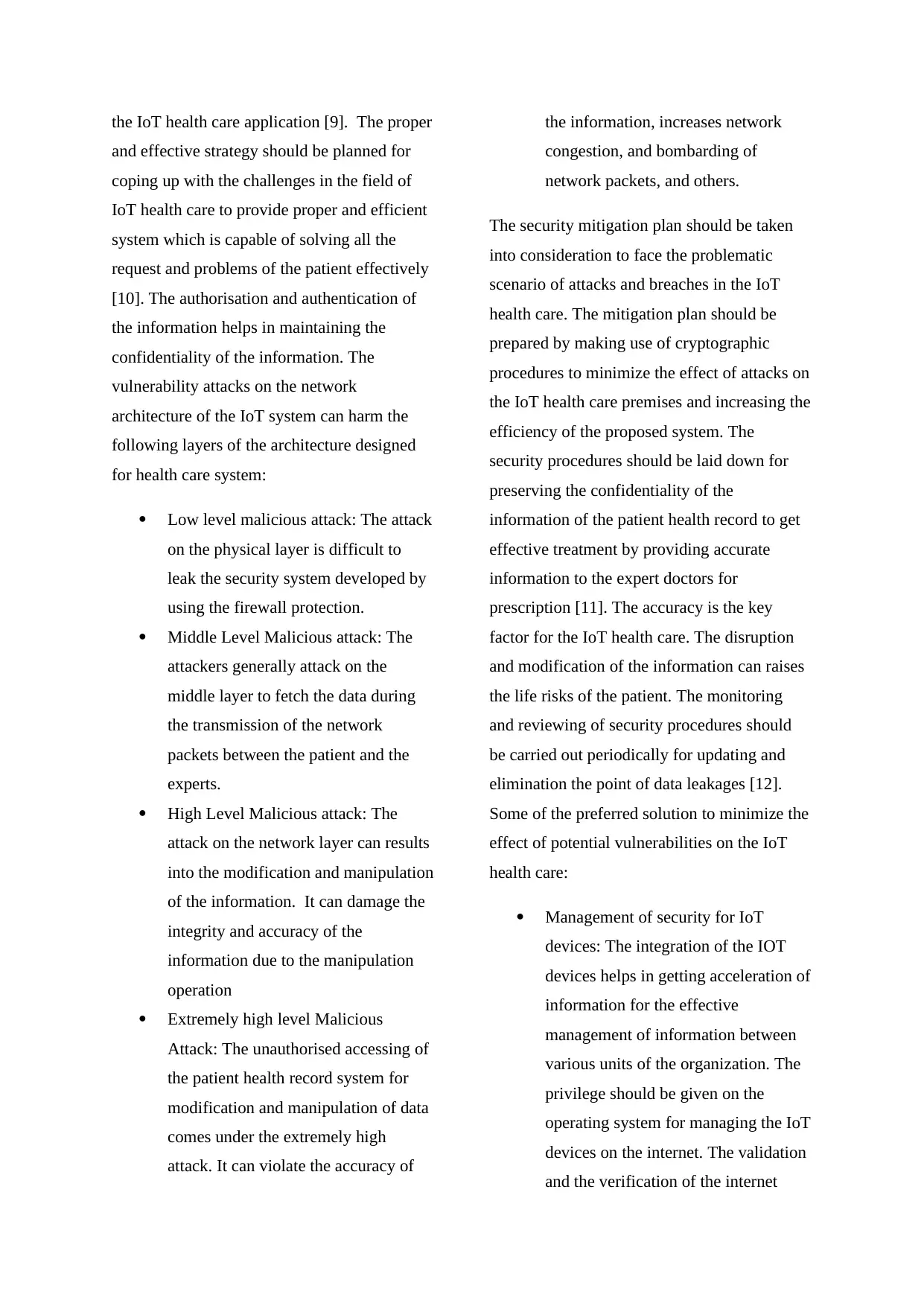
the IoT health care application [9]. The proper
and effective strategy should be planned for
coping up with the challenges in the field of
IoT health care to provide proper and efficient
system which is capable of solving all the
request and problems of the patient effectively
[10]. The authorisation and authentication of
the information helps in maintaining the
confidentiality of the information. The
vulnerability attacks on the network
architecture of the IoT system can harm the
following layers of the architecture designed
for health care system:
Low level malicious attack: The attack
on the physical layer is difficult to
leak the security system developed by
using the firewall protection.
Middle Level Malicious attack: The
attackers generally attack on the
middle layer to fetch the data during
the transmission of the network
packets between the patient and the
experts.
High Level Malicious attack: The
attack on the network layer can results
into the modification and manipulation
of the information. It can damage the
integrity and accuracy of the
information due to the manipulation
operation
Extremely high level Malicious
Attack: The unauthorised accessing of
the patient health record system for
modification and manipulation of data
comes under the extremely high
attack. It can violate the accuracy of
the information, increases network
congestion, and bombarding of
network packets, and others.
The security mitigation plan should be taken
into consideration to face the problematic
scenario of attacks and breaches in the IoT
health care. The mitigation plan should be
prepared by making use of cryptographic
procedures to minimize the effect of attacks on
the IoT health care premises and increasing the
efficiency of the proposed system. The
security procedures should be laid down for
preserving the confidentiality of the
information of the patient health record to get
effective treatment by providing accurate
information to the expert doctors for
prescription [11]. The accuracy is the key
factor for the IoT health care. The disruption
and modification of the information can raises
the life risks of the patient. The monitoring
and reviewing of security procedures should
be carried out periodically for updating and
elimination the point of data leakages [12].
Some of the preferred solution to minimize the
effect of potential vulnerabilities on the IoT
health care:
Management of security for IoT
devices: The integration of the IOT
devices helps in getting acceleration of
information for the effective
management of information between
various units of the organization. The
privilege should be given on the
operating system for managing the IoT
devices on the internet. The validation
and the verification of the internet
and effective strategy should be planned for
coping up with the challenges in the field of
IoT health care to provide proper and efficient
system which is capable of solving all the
request and problems of the patient effectively
[10]. The authorisation and authentication of
the information helps in maintaining the
confidentiality of the information. The
vulnerability attacks on the network
architecture of the IoT system can harm the
following layers of the architecture designed
for health care system:
Low level malicious attack: The attack
on the physical layer is difficult to
leak the security system developed by
using the firewall protection.
Middle Level Malicious attack: The
attackers generally attack on the
middle layer to fetch the data during
the transmission of the network
packets between the patient and the
experts.
High Level Malicious attack: The
attack on the network layer can results
into the modification and manipulation
of the information. It can damage the
integrity and accuracy of the
information due to the manipulation
operation
Extremely high level Malicious
Attack: The unauthorised accessing of
the patient health record system for
modification and manipulation of data
comes under the extremely high
attack. It can violate the accuracy of
the information, increases network
congestion, and bombarding of
network packets, and others.
The security mitigation plan should be taken
into consideration to face the problematic
scenario of attacks and breaches in the IoT
health care. The mitigation plan should be
prepared by making use of cryptographic
procedures to minimize the effect of attacks on
the IoT health care premises and increasing the
efficiency of the proposed system. The
security procedures should be laid down for
preserving the confidentiality of the
information of the patient health record to get
effective treatment by providing accurate
information to the expert doctors for
prescription [11]. The accuracy is the key
factor for the IoT health care. The disruption
and modification of the information can raises
the life risks of the patient. The monitoring
and reviewing of security procedures should
be carried out periodically for updating and
elimination the point of data leakages [12].
Some of the preferred solution to minimize the
effect of potential vulnerabilities on the IoT
health care:
Management of security for IoT
devices: The integration of the IOT
devices helps in getting acceleration of
information for the effective
management of information between
various units of the organization. The
privilege should be given on the
operating system for managing the IoT
devices on the internet. The validation
and the verification of the internet
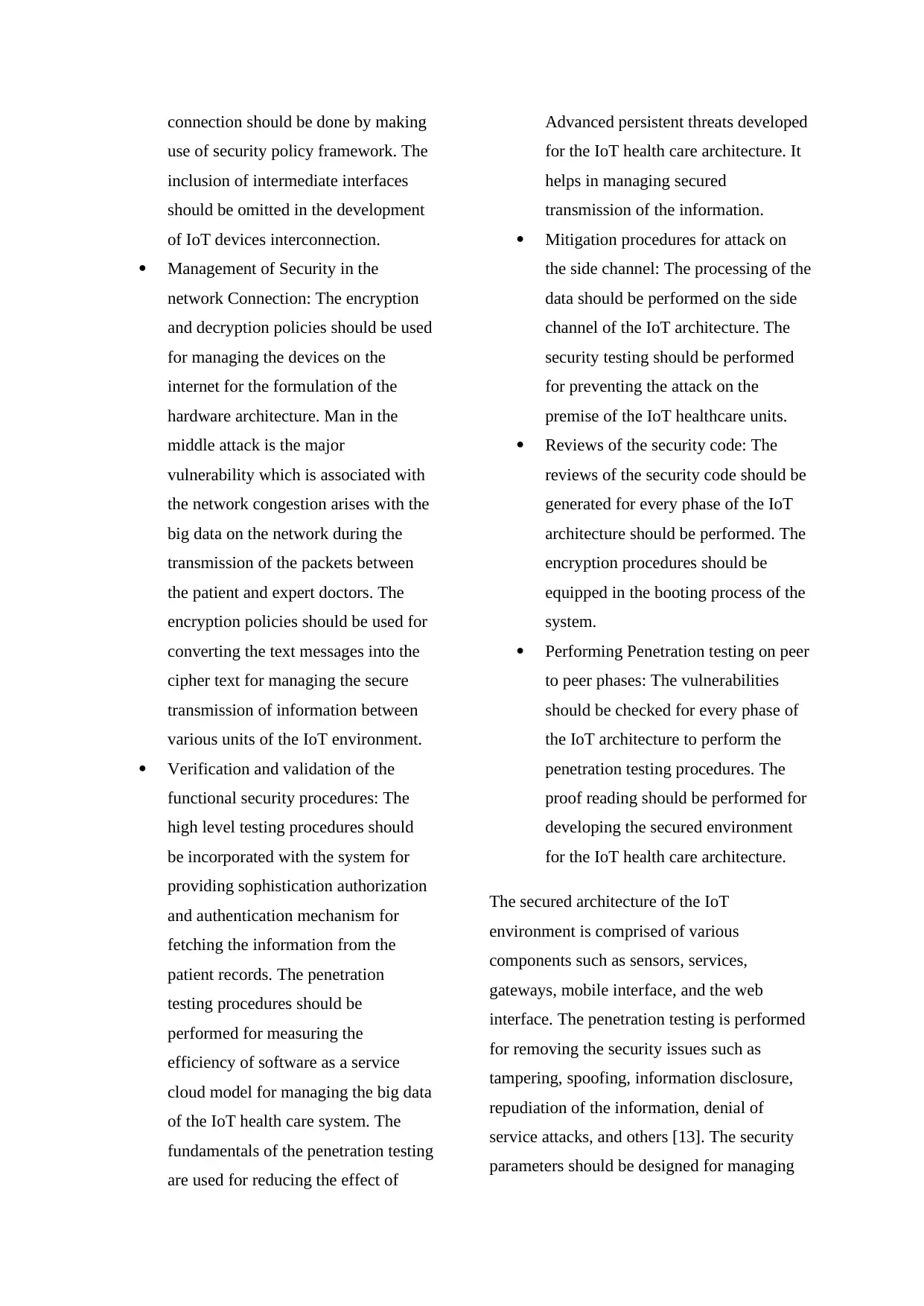
connection should be done by making
use of security policy framework. The
inclusion of intermediate interfaces
should be omitted in the development
of IoT devices interconnection.
Management of Security in the
network Connection: The encryption
and decryption policies should be used
for managing the devices on the
internet for the formulation of the
hardware architecture. Man in the
middle attack is the major
vulnerability which is associated with
the network congestion arises with the
big data on the network during the
transmission of the packets between
the patient and expert doctors. The
encryption policies should be used for
converting the text messages into the
cipher text for managing the secure
transmission of information between
various units of the IoT environment.
Verification and validation of the
functional security procedures: The
high level testing procedures should
be incorporated with the system for
providing sophistication authorization
and authentication mechanism for
fetching the information from the
patient records. The penetration
testing procedures should be
performed for measuring the
efficiency of software as a service
cloud model for managing the big data
of the IoT health care system. The
fundamentals of the penetration testing
are used for reducing the effect of
Advanced persistent threats developed
for the IoT health care architecture. It
helps in managing secured
transmission of the information.
Mitigation procedures for attack on
the side channel: The processing of the
data should be performed on the side
channel of the IoT architecture. The
security testing should be performed
for preventing the attack on the
premise of the IoT healthcare units.
Reviews of the security code: The
reviews of the security code should be
generated for every phase of the IoT
architecture should be performed. The
encryption procedures should be
equipped in the booting process of the
system.
Performing Penetration testing on peer
to peer phases: The vulnerabilities
should be checked for every phase of
the IoT architecture to perform the
penetration testing procedures. The
proof reading should be performed for
developing the secured environment
for the IoT health care architecture.
The secured architecture of the IoT
environment is comprised of various
components such as sensors, services,
gateways, mobile interface, and the web
interface. The penetration testing is performed
for removing the security issues such as
tampering, spoofing, information disclosure,
repudiation of the information, denial of
service attacks, and others [13]. The security
parameters should be designed for managing
use of security policy framework. The
inclusion of intermediate interfaces
should be omitted in the development
of IoT devices interconnection.
Management of Security in the
network Connection: The encryption
and decryption policies should be used
for managing the devices on the
internet for the formulation of the
hardware architecture. Man in the
middle attack is the major
vulnerability which is associated with
the network congestion arises with the
big data on the network during the
transmission of the packets between
the patient and expert doctors. The
encryption policies should be used for
converting the text messages into the
cipher text for managing the secure
transmission of information between
various units of the IoT environment.
Verification and validation of the
functional security procedures: The
high level testing procedures should
be incorporated with the system for
providing sophistication authorization
and authentication mechanism for
fetching the information from the
patient records. The penetration
testing procedures should be
performed for measuring the
efficiency of software as a service
cloud model for managing the big data
of the IoT health care system. The
fundamentals of the penetration testing
are used for reducing the effect of
Advanced persistent threats developed
for the IoT health care architecture. It
helps in managing secured
transmission of the information.
Mitigation procedures for attack on
the side channel: The processing of the
data should be performed on the side
channel of the IoT architecture. The
security testing should be performed
for preventing the attack on the
premise of the IoT healthcare units.
Reviews of the security code: The
reviews of the security code should be
generated for every phase of the IoT
architecture should be performed. The
encryption procedures should be
equipped in the booting process of the
system.
Performing Penetration testing on peer
to peer phases: The vulnerabilities
should be checked for every phase of
the IoT architecture to perform the
penetration testing procedures. The
proof reading should be performed for
developing the secured environment
for the IoT health care architecture.
The secured architecture of the IoT
environment is comprised of various
components such as sensors, services,
gateways, mobile interface, and the web
interface. The penetration testing is performed
for removing the security issues such as
tampering, spoofing, information disclosure,
repudiation of the information, denial of
service attacks, and others [13]. The security
parameters should be designed for managing
Paraphrase This Document
Need a fresh take? Get an instant paraphrase of this document with our AI Paraphraser

the security related to the IoT devices and
assets, cryptographic approach for managing
tampering defects, development of the secure
routing structural plan, making use of effective
low power cryptographic procedures for
preserving the complexities, and others. The
future of the IoT health care centre is very
bright. The research should be designed for
increasing the reachability of the patient to the
IoT health care with the inclusion of minimum
cost required to get effective treatment. The
remote monitoring of the patient by the expert
doctors increases the reachability to the
patients who geographically distant apart from
the patient. The patients are provided effective
treatment in the comfort of their home. It also
helps the family members to take effective
care of the patients. The video sensors and the
CCTV cameras helps in increasing the analysis
of the daily routine activities performed by the
patients which helps in measuring the signs of
improvements. The implementation of the
mitigation procedures helps in developing
effective and efficient system for IoT health
car to provide quality of service to the patient
in their home care centre. The mitigation
procedures such as development of secure
socket layer and encryption policies to
eliminate the risks and the threats associated
with the IoT health care system.
VII. Issues / Challenges / Solutions:
The traditional working of the medical
industry was facing problem in handling the
big data of the patient systematically. In the
emergency situation the chance of patient life
risks is increasing to reach to the hospitals.
The realization of these problems gives rise to
the development of IoT health care system. It
helps in maintaining the electronic health
records of the patient which can be retrieved
by multiple doctors at a time to study the
patient case. The major problem with the IoT
system is the security of the personal data
uploaded by the patient. The effective working
of the health care system depends on the
maintenance of accuracy with the premises of
the IoT devices and assets. The patient can get
effective treatment in his home care by the
active participation of the medical officers and
experts from Global level. The complex and
critical condition can effectively solved by
taking suggestions from the different experts
sitting at global level through the common
platform of IoT health care. The
implementation of IoT health care faces some
challenges and issues in carrying out the task
of effective management of health services.
Some of the issues which exist with the IoT
health care are listed below:
Issues Description
Technical Risks The availability of required
hardware and software at
the home care centre of the
patient to reviewed critical
condition of the patient
while sitting
geographically apart from
the patient. It requires the
implementation of video
cameras, sensors, heart
assets, cryptographic approach for managing
tampering defects, development of the secure
routing structural plan, making use of effective
low power cryptographic procedures for
preserving the complexities, and others. The
future of the IoT health care centre is very
bright. The research should be designed for
increasing the reachability of the patient to the
IoT health care with the inclusion of minimum
cost required to get effective treatment. The
remote monitoring of the patient by the expert
doctors increases the reachability to the
patients who geographically distant apart from
the patient. The patients are provided effective
treatment in the comfort of their home. It also
helps the family members to take effective
care of the patients. The video sensors and the
CCTV cameras helps in increasing the analysis
of the daily routine activities performed by the
patients which helps in measuring the signs of
improvements. The implementation of the
mitigation procedures helps in developing
effective and efficient system for IoT health
car to provide quality of service to the patient
in their home care centre. The mitigation
procedures such as development of secure
socket layer and encryption policies to
eliminate the risks and the threats associated
with the IoT health care system.
VII. Issues / Challenges / Solutions:
The traditional working of the medical
industry was facing problem in handling the
big data of the patient systematically. In the
emergency situation the chance of patient life
risks is increasing to reach to the hospitals.
The realization of these problems gives rise to
the development of IoT health care system. It
helps in maintaining the electronic health
records of the patient which can be retrieved
by multiple doctors at a time to study the
patient case. The major problem with the IoT
system is the security of the personal data
uploaded by the patient. The effective working
of the health care system depends on the
maintenance of accuracy with the premises of
the IoT devices and assets. The patient can get
effective treatment in his home care by the
active participation of the medical officers and
experts from Global level. The complex and
critical condition can effectively solved by
taking suggestions from the different experts
sitting at global level through the common
platform of IoT health care. The
implementation of IoT health care faces some
challenges and issues in carrying out the task
of effective management of health services.
Some of the issues which exist with the IoT
health care are listed below:
Issues Description
Technical Risks The availability of required
hardware and software at
the home care centre of the
patient to reviewed critical
condition of the patient
while sitting
geographically apart from
the patient. It requires the
implementation of video
cameras, sensors, heart
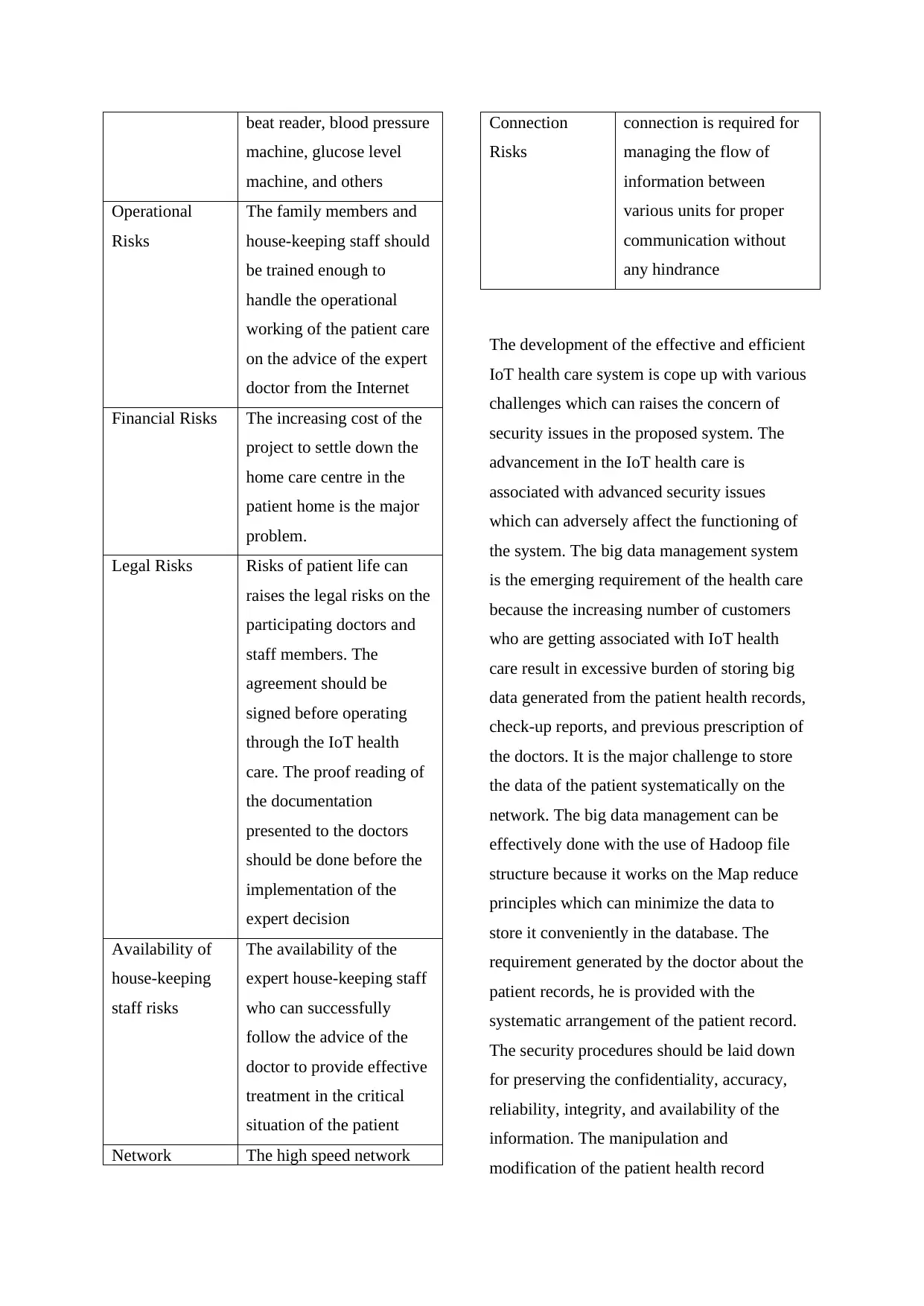
beat reader, blood pressure
machine, glucose level
machine, and others
Operational
Risks
The family members and
house-keeping staff should
be trained enough to
handle the operational
working of the patient care
on the advice of the expert
doctor from the Internet
Financial Risks The increasing cost of the
project to settle down the
home care centre in the
patient home is the major
problem.
Legal Risks Risks of patient life can
raises the legal risks on the
participating doctors and
staff members. The
agreement should be
signed before operating
through the IoT health
care. The proof reading of
the documentation
presented to the doctors
should be done before the
implementation of the
expert decision
Availability of
house-keeping
staff risks
The availability of the
expert house-keeping staff
who can successfully
follow the advice of the
doctor to provide effective
treatment in the critical
situation of the patient
Network The high speed network
Connection
Risks
connection is required for
managing the flow of
information between
various units for proper
communication without
any hindrance
The development of the effective and efficient
IoT health care system is cope up with various
challenges which can raises the concern of
security issues in the proposed system. The
advancement in the IoT health care is
associated with advanced security issues
which can adversely affect the functioning of
the system. The big data management system
is the emerging requirement of the health care
because the increasing number of customers
who are getting associated with IoT health
care result in excessive burden of storing big
data generated from the patient health records,
check-up reports, and previous prescription of
the doctors. It is the major challenge to store
the data of the patient systematically on the
network. The big data management can be
effectively done with the use of Hadoop file
structure because it works on the Map reduce
principles which can minimize the data to
store it conveniently in the database. The
requirement generated by the doctor about the
patient records, he is provided with the
systematic arrangement of the patient record.
The security procedures should be laid down
for preserving the confidentiality, accuracy,
reliability, integrity, and availability of the
information. The manipulation and
modification of the patient health record
machine, glucose level
machine, and others
Operational
Risks
The family members and
house-keeping staff should
be trained enough to
handle the operational
working of the patient care
on the advice of the expert
doctor from the Internet
Financial Risks The increasing cost of the
project to settle down the
home care centre in the
patient home is the major
problem.
Legal Risks Risks of patient life can
raises the legal risks on the
participating doctors and
staff members. The
agreement should be
signed before operating
through the IoT health
care. The proof reading of
the documentation
presented to the doctors
should be done before the
implementation of the
expert decision
Availability of
house-keeping
staff risks
The availability of the
expert house-keeping staff
who can successfully
follow the advice of the
doctor to provide effective
treatment in the critical
situation of the patient
Network The high speed network
Connection
Risks
connection is required for
managing the flow of
information between
various units for proper
communication without
any hindrance
The development of the effective and efficient
IoT health care system is cope up with various
challenges which can raises the concern of
security issues in the proposed system. The
advancement in the IoT health care is
associated with advanced security issues
which can adversely affect the functioning of
the system. The big data management system
is the emerging requirement of the health care
because the increasing number of customers
who are getting associated with IoT health
care result in excessive burden of storing big
data generated from the patient health records,
check-up reports, and previous prescription of
the doctors. It is the major challenge to store
the data of the patient systematically on the
network. The big data management can be
effectively done with the use of Hadoop file
structure because it works on the Map reduce
principles which can minimize the data to
store it conveniently in the database. The
requirement generated by the doctor about the
patient records, he is provided with the
systematic arrangement of the patient record.
The security procedures should be laid down
for preserving the confidentiality, accuracy,
reliability, integrity, and availability of the
information. The manipulation and
modification of the patient health record
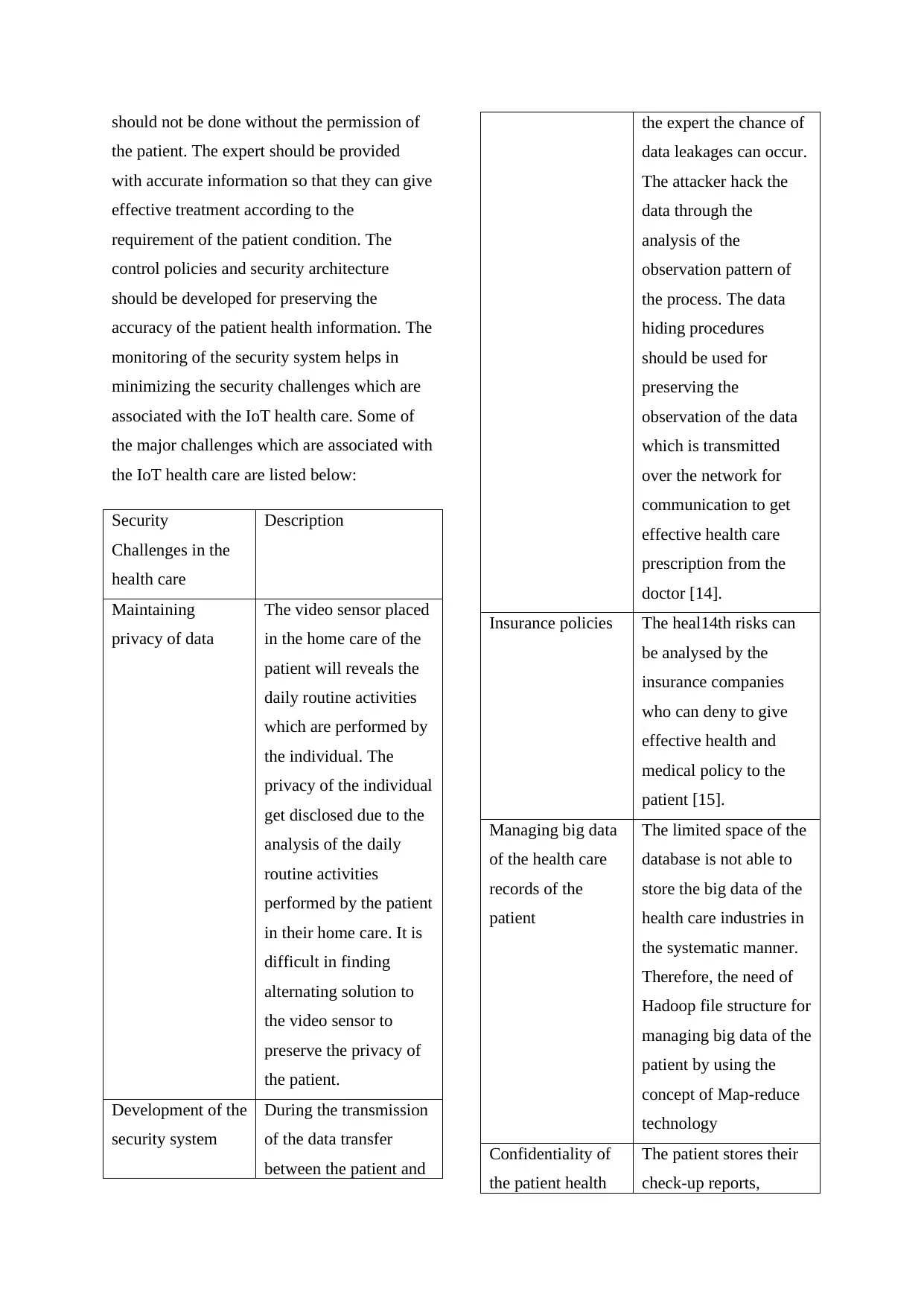
should not be done without the permission of
the patient. The expert should be provided
with accurate information so that they can give
effective treatment according to the
requirement of the patient condition. The
control policies and security architecture
should be developed for preserving the
accuracy of the patient health information. The
monitoring of the security system helps in
minimizing the security challenges which are
associated with the IoT health care. Some of
the major challenges which are associated with
the IoT health care are listed below:
Security
Challenges in the
health care
Description
Maintaining
privacy of data
The video sensor placed
in the home care of the
patient will reveals the
daily routine activities
which are performed by
the individual. The
privacy of the individual
get disclosed due to the
analysis of the daily
routine activities
performed by the patient
in their home care. It is
difficult in finding
alternating solution to
the video sensor to
preserve the privacy of
the patient.
Development of the
security system
During the transmission
of the data transfer
between the patient and
the expert the chance of
data leakages can occur.
The attacker hack the
data through the
analysis of the
observation pattern of
the process. The data
hiding procedures
should be used for
preserving the
observation of the data
which is transmitted
over the network for
communication to get
effective health care
prescription from the
doctor [14].
Insurance policies The heal14th risks can
be analysed by the
insurance companies
who can deny to give
effective health and
medical policy to the
patient [15].
Managing big data
of the health care
records of the
patient
The limited space of the
database is not able to
store the big data of the
health care industries in
the systematic manner.
Therefore, the need of
Hadoop file structure for
managing big data of the
patient by using the
concept of Map-reduce
technology
Confidentiality of
the patient health
The patient stores their
check-up reports,
the patient. The expert should be provided
with accurate information so that they can give
effective treatment according to the
requirement of the patient condition. The
control policies and security architecture
should be developed for preserving the
accuracy of the patient health information. The
monitoring of the security system helps in
minimizing the security challenges which are
associated with the IoT health care. Some of
the major challenges which are associated with
the IoT health care are listed below:
Security
Challenges in the
health care
Description
Maintaining
privacy of data
The video sensor placed
in the home care of the
patient will reveals the
daily routine activities
which are performed by
the individual. The
privacy of the individual
get disclosed due to the
analysis of the daily
routine activities
performed by the patient
in their home care. It is
difficult in finding
alternating solution to
the video sensor to
preserve the privacy of
the patient.
Development of the
security system
During the transmission
of the data transfer
between the patient and
the expert the chance of
data leakages can occur.
The attacker hack the
data through the
analysis of the
observation pattern of
the process. The data
hiding procedures
should be used for
preserving the
observation of the data
which is transmitted
over the network for
communication to get
effective health care
prescription from the
doctor [14].
Insurance policies The heal14th risks can
be analysed by the
insurance companies
who can deny to give
effective health and
medical policy to the
patient [15].
Managing big data
of the health care
records of the
patient
The limited space of the
database is not able to
store the big data of the
health care industries in
the systematic manner.
Therefore, the need of
Hadoop file structure for
managing big data of the
patient by using the
concept of Map-reduce
technology
Confidentiality of
the patient health
The patient stores their
check-up reports,
Secure Best Marks with AI Grader
Need help grading? Try our AI Grader for instant feedback on your assignments.
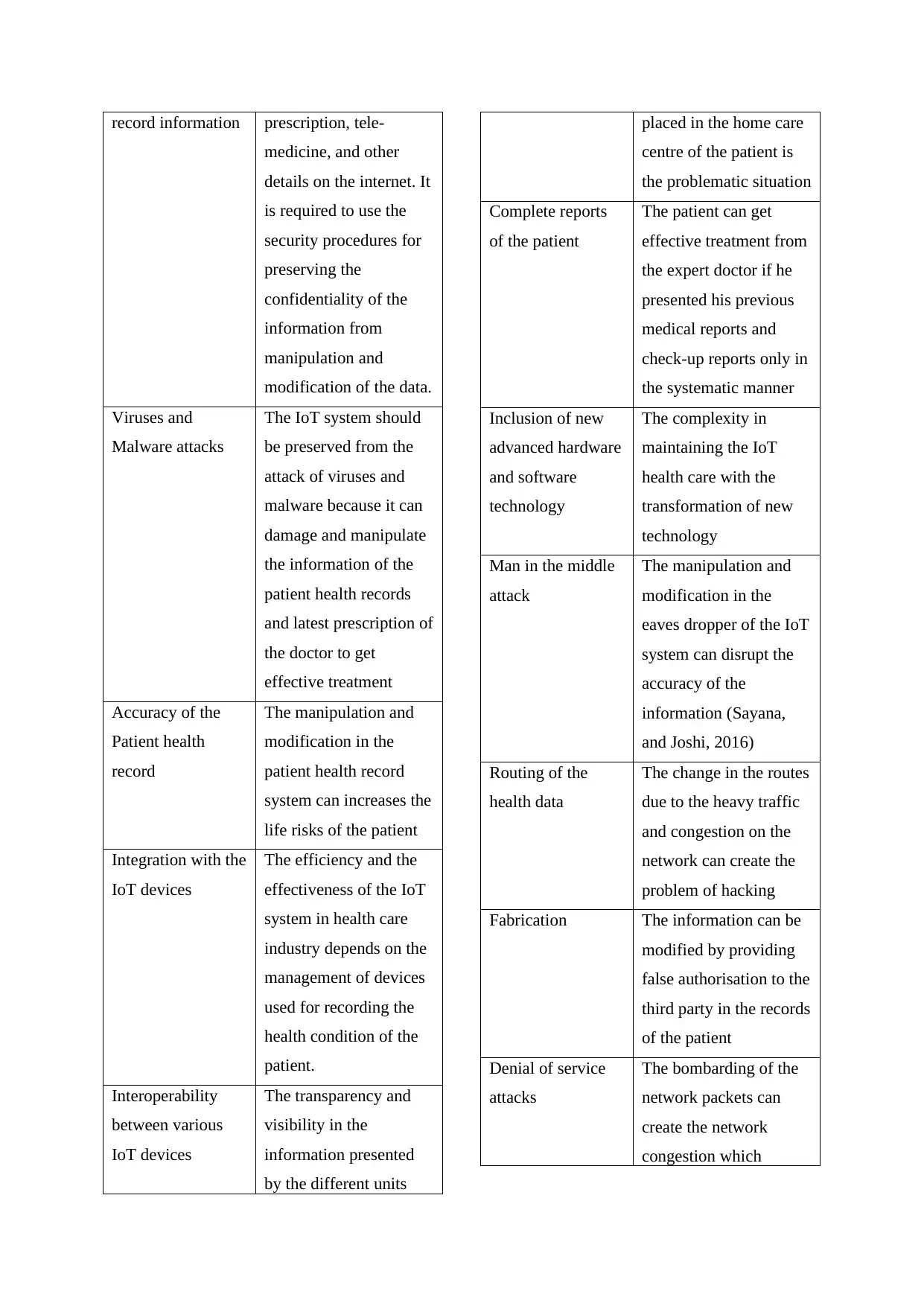
record information prescription, tele-
medicine, and other
details on the internet. It
is required to use the
security procedures for
preserving the
confidentiality of the
information from
manipulation and
modification of the data.
Viruses and
Malware attacks
The IoT system should
be preserved from the
attack of viruses and
malware because it can
damage and manipulate
the information of the
patient health records
and latest prescription of
the doctor to get
effective treatment
Accuracy of the
Patient health
record
The manipulation and
modification in the
patient health record
system can increases the
life risks of the patient
Integration with the
IoT devices
The efficiency and the
effectiveness of the IoT
system in health care
industry depends on the
management of devices
used for recording the
health condition of the
patient.
Interoperability
between various
IoT devices
The transparency and
visibility in the
information presented
by the different units
placed in the home care
centre of the patient is
the problematic situation
Complete reports
of the patient
The patient can get
effective treatment from
the expert doctor if he
presented his previous
medical reports and
check-up reports only in
the systematic manner
Inclusion of new
advanced hardware
and software
technology
The complexity in
maintaining the IoT
health care with the
transformation of new
technology
Man in the middle
attack
The manipulation and
modification in the
eaves dropper of the IoT
system can disrupt the
accuracy of the
information (Sayana,
and Joshi, 2016)
Routing of the
health data
The change in the routes
due to the heavy traffic
and congestion on the
network can create the
problem of hacking
Fabrication The information can be
modified by providing
false authorisation to the
third party in the records
of the patient
Denial of service
attacks
The bombarding of the
network packets can
create the network
congestion which
medicine, and other
details on the internet. It
is required to use the
security procedures for
preserving the
confidentiality of the
information from
manipulation and
modification of the data.
Viruses and
Malware attacks
The IoT system should
be preserved from the
attack of viruses and
malware because it can
damage and manipulate
the information of the
patient health records
and latest prescription of
the doctor to get
effective treatment
Accuracy of the
Patient health
record
The manipulation and
modification in the
patient health record
system can increases the
life risks of the patient
Integration with the
IoT devices
The efficiency and the
effectiveness of the IoT
system in health care
industry depends on the
management of devices
used for recording the
health condition of the
patient.
Interoperability
between various
IoT devices
The transparency and
visibility in the
information presented
by the different units
placed in the home care
centre of the patient is
the problematic situation
Complete reports
of the patient
The patient can get
effective treatment from
the expert doctor if he
presented his previous
medical reports and
check-up reports only in
the systematic manner
Inclusion of new
advanced hardware
and software
technology
The complexity in
maintaining the IoT
health care with the
transformation of new
technology
Man in the middle
attack
The manipulation and
modification in the
eaves dropper of the IoT
system can disrupt the
accuracy of the
information (Sayana,
and Joshi, 2016)
Routing of the
health data
The change in the routes
due to the heavy traffic
and congestion on the
network can create the
problem of hacking
Fabrication The information can be
modified by providing
false authorisation to the
third party in the records
of the patient
Denial of service
attacks
The bombarding of the
network packets can
create the network
congestion which
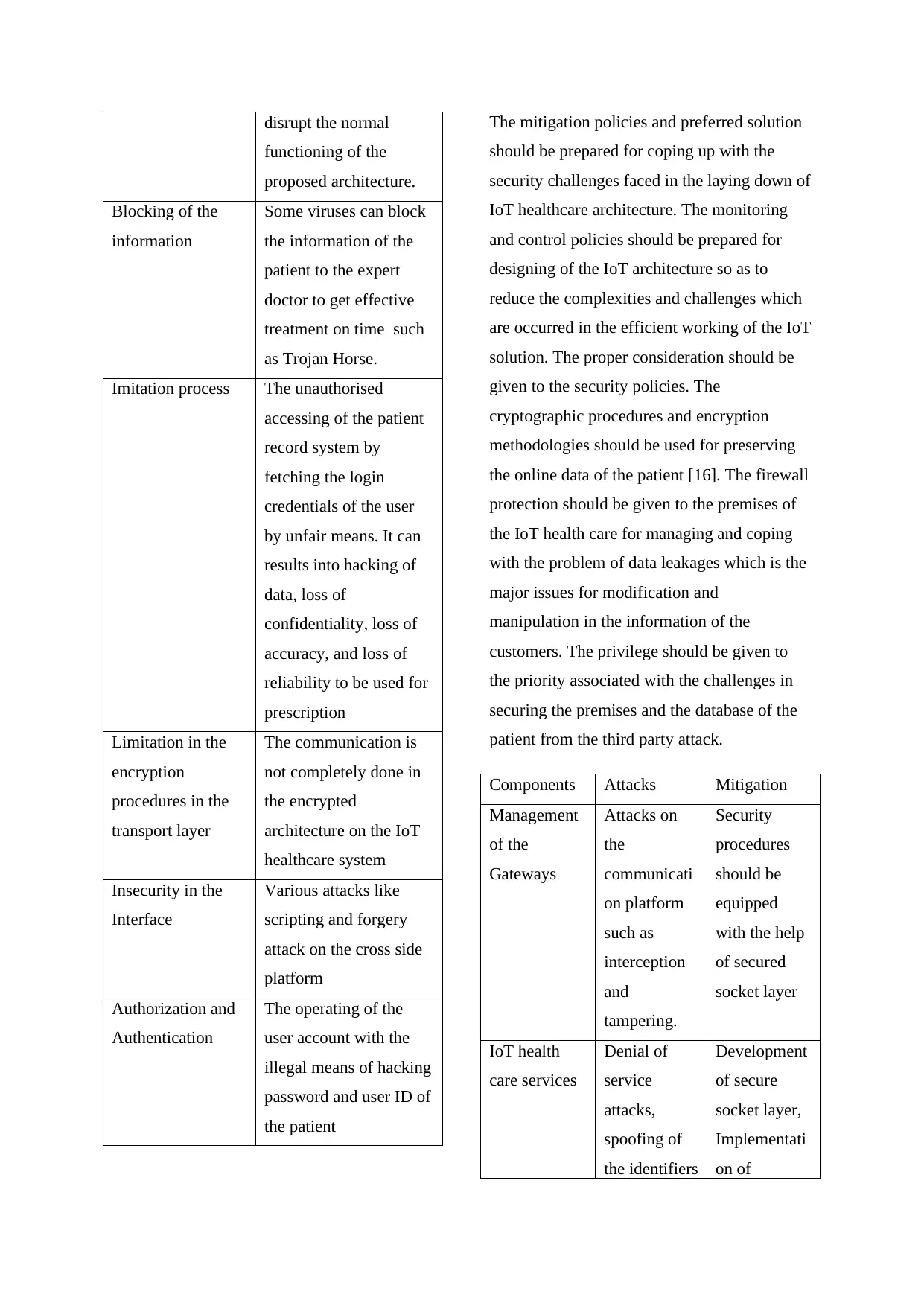
disrupt the normal
functioning of the
proposed architecture.
Blocking of the
information
Some viruses can block
the information of the
patient to the expert
doctor to get effective
treatment on time such
as Trojan Horse.
Imitation process The unauthorised
accessing of the patient
record system by
fetching the login
credentials of the user
by unfair means. It can
results into hacking of
data, loss of
confidentiality, loss of
accuracy, and loss of
reliability to be used for
prescription
Limitation in the
encryption
procedures in the
transport layer
The communication is
not completely done in
the encrypted
architecture on the IoT
healthcare system
Insecurity in the
Interface
Various attacks like
scripting and forgery
attack on the cross side
platform
Authorization and
Authentication
The operating of the
user account with the
illegal means of hacking
password and user ID of
the patient
The mitigation policies and preferred solution
should be prepared for coping up with the
security challenges faced in the laying down of
IoT healthcare architecture. The monitoring
and control policies should be prepared for
designing of the IoT architecture so as to
reduce the complexities and challenges which
are occurred in the efficient working of the IoT
solution. The proper consideration should be
given to the security policies. The
cryptographic procedures and encryption
methodologies should be used for preserving
the online data of the patient [16]. The firewall
protection should be given to the premises of
the IoT health care for managing and coping
with the problem of data leakages which is the
major issues for modification and
manipulation in the information of the
customers. The privilege should be given to
the priority associated with the challenges in
securing the premises and the database of the
patient from the third party attack.
Components Attacks Mitigation
Management
of the
Gateways
Attacks on
the
communicati
on platform
such as
interception
and
tampering.
Security
procedures
should be
equipped
with the help
of secured
socket layer
IoT health
care services
Denial of
service
attacks,
spoofing of
the identifiers
Development
of secure
socket layer,
Implementati
on of
functioning of the
proposed architecture.
Blocking of the
information
Some viruses can block
the information of the
patient to the expert
doctor to get effective
treatment on time such
as Trojan Horse.
Imitation process The unauthorised
accessing of the patient
record system by
fetching the login
credentials of the user
by unfair means. It can
results into hacking of
data, loss of
confidentiality, loss of
accuracy, and loss of
reliability to be used for
prescription
Limitation in the
encryption
procedures in the
transport layer
The communication is
not completely done in
the encrypted
architecture on the IoT
healthcare system
Insecurity in the
Interface
Various attacks like
scripting and forgery
attack on the cross side
platform
Authorization and
Authentication
The operating of the
user account with the
illegal means of hacking
password and user ID of
the patient
The mitigation policies and preferred solution
should be prepared for coping up with the
security challenges faced in the laying down of
IoT healthcare architecture. The monitoring
and control policies should be prepared for
designing of the IoT architecture so as to
reduce the complexities and challenges which
are occurred in the efficient working of the IoT
solution. The proper consideration should be
given to the security policies. The
cryptographic procedures and encryption
methodologies should be used for preserving
the online data of the patient [16]. The firewall
protection should be given to the premises of
the IoT health care for managing and coping
with the problem of data leakages which is the
major issues for modification and
manipulation in the information of the
customers. The privilege should be given to
the priority associated with the challenges in
securing the premises and the database of the
patient from the third party attack.
Components Attacks Mitigation
Management
of the
Gateways
Attacks on
the
communicati
on platform
such as
interception
and
tampering.
Security
procedures
should be
equipped
with the help
of secured
socket layer
IoT health
care services
Denial of
service
attacks,
spoofing of
the identifiers
Development
of secure
socket layer,
Implementati
on of
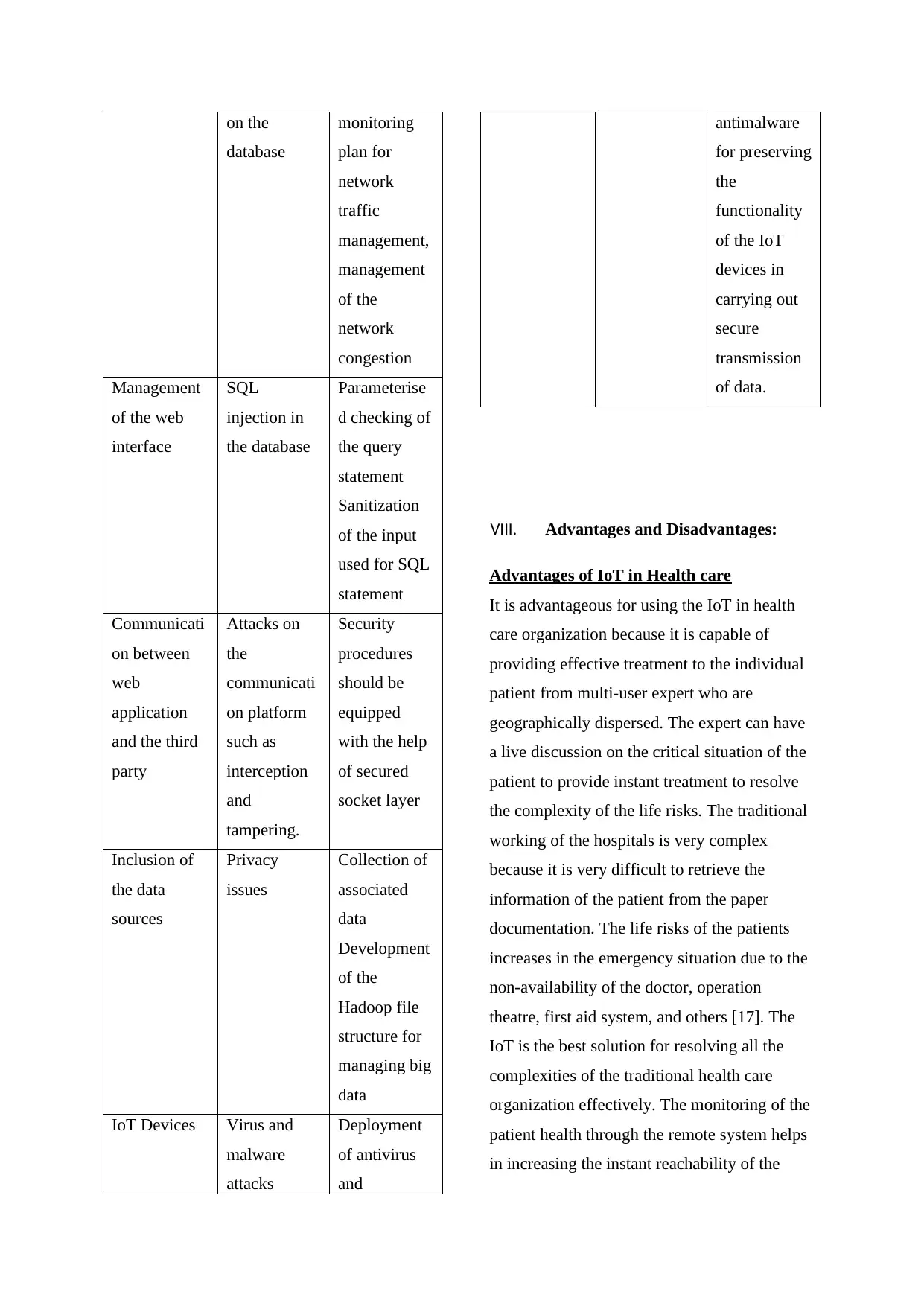
on the
database
monitoring
plan for
network
traffic
management,
management
of the
network
congestion
Management
of the web
interface
SQL
injection in
the database
Parameterise
d checking of
the query
statement
Sanitization
of the input
used for SQL
statement
Communicati
on between
web
application
and the third
party
Attacks on
the
communicati
on platform
such as
interception
and
tampering.
Security
procedures
should be
equipped
with the help
of secured
socket layer
Inclusion of
the data
sources
Privacy
issues
Collection of
associated
data
Development
of the
Hadoop file
structure for
managing big
data
IoT Devices Virus and
malware
attacks
Deployment
of antivirus
and
antimalware
for preserving
the
functionality
of the IoT
devices in
carrying out
secure
transmission
of data.
VIII. Advantages and Disadvantages:
Advantages of IoT in Health care
It is advantageous for using the IoT in health
care organization because it is capable of
providing effective treatment to the individual
patient from multi-user expert who are
geographically dispersed. The expert can have
a live discussion on the critical situation of the
patient to provide instant treatment to resolve
the complexity of the life risks. The traditional
working of the hospitals is very complex
because it is very difficult to retrieve the
information of the patient from the paper
documentation. The life risks of the patients
increases in the emergency situation due to the
non-availability of the doctor, operation
theatre, first aid system, and others [17]. The
IoT is the best solution for resolving all the
complexities of the traditional health care
organization effectively. The monitoring of the
patient health through the remote system helps
in increasing the instant reachability of the
database
monitoring
plan for
network
traffic
management,
management
of the
network
congestion
Management
of the web
interface
SQL
injection in
the database
Parameterise
d checking of
the query
statement
Sanitization
of the input
used for SQL
statement
Communicati
on between
web
application
and the third
party
Attacks on
the
communicati
on platform
such as
interception
and
tampering.
Security
procedures
should be
equipped
with the help
of secured
socket layer
Inclusion of
the data
sources
Privacy
issues
Collection of
associated
data
Development
of the
Hadoop file
structure for
managing big
data
IoT Devices Virus and
malware
attacks
Deployment
of antivirus
and
antimalware
for preserving
the
functionality
of the IoT
devices in
carrying out
secure
transmission
of data.
VIII. Advantages and Disadvantages:
Advantages of IoT in Health care
It is advantageous for using the IoT in health
care organization because it is capable of
providing effective treatment to the individual
patient from multi-user expert who are
geographically dispersed. The expert can have
a live discussion on the critical situation of the
patient to provide instant treatment to resolve
the complexity of the life risks. The traditional
working of the hospitals is very complex
because it is very difficult to retrieve the
information of the patient from the paper
documentation. The life risks of the patients
increases in the emergency situation due to the
non-availability of the doctor, operation
theatre, first aid system, and others [17]. The
IoT is the best solution for resolving all the
complexities of the traditional health care
organization effectively. The monitoring of the
patient health through the remote system helps
in increasing the instant reachability of the
Paraphrase This Document
Need a fresh take? Get an instant paraphrase of this document with our AI Paraphraser

doctors in instant situation. The IoT is
beneficial in managing the control over the
patient life risks effectively. Some of the major
benefits of using the IoT in healthcare are
given below:
Higher efficiency and engagement to the
patient: The remote monitoring system of the
IOT health care helps in providing effective
treatment to cope up with the critical situation
of the patient. The effective first aid provided
to the patient in home care helps in improving
the patient life. The patient should upload his
records on the database of the IoT system. The
progress of the system depends on the
accuracy of the information provided by the
patient to the doctors. The experts can refer to
the previous reports of the patient to give
instant prescription.
Better result: The outcome of the IOT health
care can be measured on the basis of
preserving the life of the patient. The patients
are provided with the real time treatment in the
home care of their houses. The IoT health care
works on improving the health condition of the
patient effectively by analysing the daily
activity schedule of the patient. The patients
are monitored by multiple experts at a time to
give effective treatment. It can be seen that the
life of the patient can be secured by managing
the treatment in the home care. It avoids the
time consumed in taking appointments in the
emergency situation of the patient.
Accuracy in the health treatment: The
accuracy in providing effective treatment to
the patient is the core advantage of using the
IOT in health care. The effective treatment can
be provided to the patient for improving the
critical condition by getting advice from the
multiple medical experts. The patients provide
their previous health records to the expert
doctor to analyse the case and helpful in giving
appropriate advice according to the situation
analysis. The recommendations from the
expert doctors from the global location can be
taken on the complex situation of the patients.
Comfort to patient: The patients are getting
treatment in their home environment which
increases their feasibility in getting things
done. The patients feel comfortable in getting
treatment in their home care centre.
Use of cloud environment: The cloud
computing environment increases the
feasibility of getting approach to the
information provided by the patients because
the Hadoop file system helps in arranging the
data in the sequential manner [18].
Tracking of patient condition: The monitoring
of the patient can be effectively done with the
use of IOT devices such as video sensor, video
cameras, device for glucose sugar level
requirement, and others. The alert messages
are generated on the system and mobile
devices of the medical experts who are
connected with the IOT environment about the
patient who are in critical stages [19].
Remote monitoring system: It is a time
effective technology. The patient who is in
critical stage requires treatment in emergency.
In the traditional working, lots of time is get
wasted in selecting hospital, reachability to the
beneficial in managing the control over the
patient life risks effectively. Some of the major
benefits of using the IoT in healthcare are
given below:
Higher efficiency and engagement to the
patient: The remote monitoring system of the
IOT health care helps in providing effective
treatment to cope up with the critical situation
of the patient. The effective first aid provided
to the patient in home care helps in improving
the patient life. The patient should upload his
records on the database of the IoT system. The
progress of the system depends on the
accuracy of the information provided by the
patient to the doctors. The experts can refer to
the previous reports of the patient to give
instant prescription.
Better result: The outcome of the IOT health
care can be measured on the basis of
preserving the life of the patient. The patients
are provided with the real time treatment in the
home care of their houses. The IoT health care
works on improving the health condition of the
patient effectively by analysing the daily
activity schedule of the patient. The patients
are monitored by multiple experts at a time to
give effective treatment. It can be seen that the
life of the patient can be secured by managing
the treatment in the home care. It avoids the
time consumed in taking appointments in the
emergency situation of the patient.
Accuracy in the health treatment: The
accuracy in providing effective treatment to
the patient is the core advantage of using the
IOT in health care. The effective treatment can
be provided to the patient for improving the
critical condition by getting advice from the
multiple medical experts. The patients provide
their previous health records to the expert
doctor to analyse the case and helpful in giving
appropriate advice according to the situation
analysis. The recommendations from the
expert doctors from the global location can be
taken on the complex situation of the patients.
Comfort to patient: The patients are getting
treatment in their home environment which
increases their feasibility in getting things
done. The patients feel comfortable in getting
treatment in their home care centre.
Use of cloud environment: The cloud
computing environment increases the
feasibility of getting approach to the
information provided by the patients because
the Hadoop file system helps in arranging the
data in the sequential manner [18].
Tracking of patient condition: The monitoring
of the patient can be effectively done with the
use of IOT devices such as video sensor, video
cameras, device for glucose sugar level
requirement, and others. The alert messages
are generated on the system and mobile
devices of the medical experts who are
connected with the IOT environment about the
patient who are in critical stages [19].
Remote monitoring system: It is a time
effective technology. The patient who is in
critical stage requires treatment in emergency.
In the traditional working, lots of time is get
wasted in selecting hospital, reachability to the

hospital, checking availability of the expert
doctors, availability of operation theatre, and
others. The IOT is the preferred solution to
resolve these complexities because it is
providing real time monitoring of the patient
health in the home care centre through the IoT
devices. It does not require to take
appointment, checking availability of the
doctors, and others. The instant medical
treatment can be provided to the patients in the
home care centre [20].
Communication: The IoT environment is
based on machine to machine communication
which is efficient for sending relevant
information on the patient and doctor working
environment.
Big data management: The cloud computing
environment increases the feasibility of getting
approach to the information provided by the
patients because the Hadoop file system helps
in arranging the data in the sequential manner.
Disadvantages of IOT in health care
The deployment of the IoT in health care
environment is cope up with numerous
disadvantages too. The major problem with the
IoT system is the security of the personal data
uploaded by the patient. The effective working
of the health care system depends on the
maintenance of accuracy with the premises of
the IoT devices and assets. The management
of the big data generated is the basic necessity
of the IoT health care because of the
increasing number of patients associated with
the IoT environment can increase the risks of
inefficiency in managing systematic retrieval
and information flow between various units of
the healthcare environment. Some of the
disadvantages associated with the IoT health
care centre are highlighted below:
Security: The security is the major concern in
the IoT environment because the third party or
hackers can retrieve the information of the
patient personal information during the
transmission of information between patients
and doctors. The loss of confidentiality can
results in threats to the personal data of the
patients which is stored on the IoT health care
cloud environment.
Cost: The installation of the heavy machines
for the check-up of the patients heartbeat,
glucose level, video sensors, CCTV cameras,
and other can increases the cost of the medical
treatment provided to the patients.
Complexity: The network management of the
IoT devices is the complex tasks because it is a
set-up of various IoT devices which are used
for checking the health condition of the
patients.
Privacy: The deployment of the video cameras
and sensors will result in keeping records of
daily activities program carried out by the
patient in their home care. The information of
the daily activities program is stored on the
public cloud for retrieving the information
according to the demand of the experts.
Accuracy: The IoT health care environment
works on the fundamentals of accuracy
program. The security procedures should be
laid down for preserving the loss of data from
doctors, availability of operation theatre, and
others. The IOT is the preferred solution to
resolve these complexities because it is
providing real time monitoring of the patient
health in the home care centre through the IoT
devices. It does not require to take
appointment, checking availability of the
doctors, and others. The instant medical
treatment can be provided to the patients in the
home care centre [20].
Communication: The IoT environment is
based on machine to machine communication
which is efficient for sending relevant
information on the patient and doctor working
environment.
Big data management: The cloud computing
environment increases the feasibility of getting
approach to the information provided by the
patients because the Hadoop file system helps
in arranging the data in the sequential manner.
Disadvantages of IOT in health care
The deployment of the IoT in health care
environment is cope up with numerous
disadvantages too. The major problem with the
IoT system is the security of the personal data
uploaded by the patient. The effective working
of the health care system depends on the
maintenance of accuracy with the premises of
the IoT devices and assets. The management
of the big data generated is the basic necessity
of the IoT health care because of the
increasing number of patients associated with
the IoT environment can increase the risks of
inefficiency in managing systematic retrieval
and information flow between various units of
the healthcare environment. Some of the
disadvantages associated with the IoT health
care centre are highlighted below:
Security: The security is the major concern in
the IoT environment because the third party or
hackers can retrieve the information of the
patient personal information during the
transmission of information between patients
and doctors. The loss of confidentiality can
results in threats to the personal data of the
patients which is stored on the IoT health care
cloud environment.
Cost: The installation of the heavy machines
for the check-up of the patients heartbeat,
glucose level, video sensors, CCTV cameras,
and other can increases the cost of the medical
treatment provided to the patients.
Complexity: The network management of the
IoT devices is the complex tasks because it is a
set-up of various IoT devices which are used
for checking the health condition of the
patients.
Privacy: The deployment of the video cameras
and sensors will result in keeping records of
daily activities program carried out by the
patient in their home care. The information of
the daily activities program is stored on the
public cloud for retrieving the information
according to the demand of the experts.
Accuracy: The IoT health care environment
works on the fundamentals of accuracy
program. The security procedures should be
laid down for preserving the loss of data from
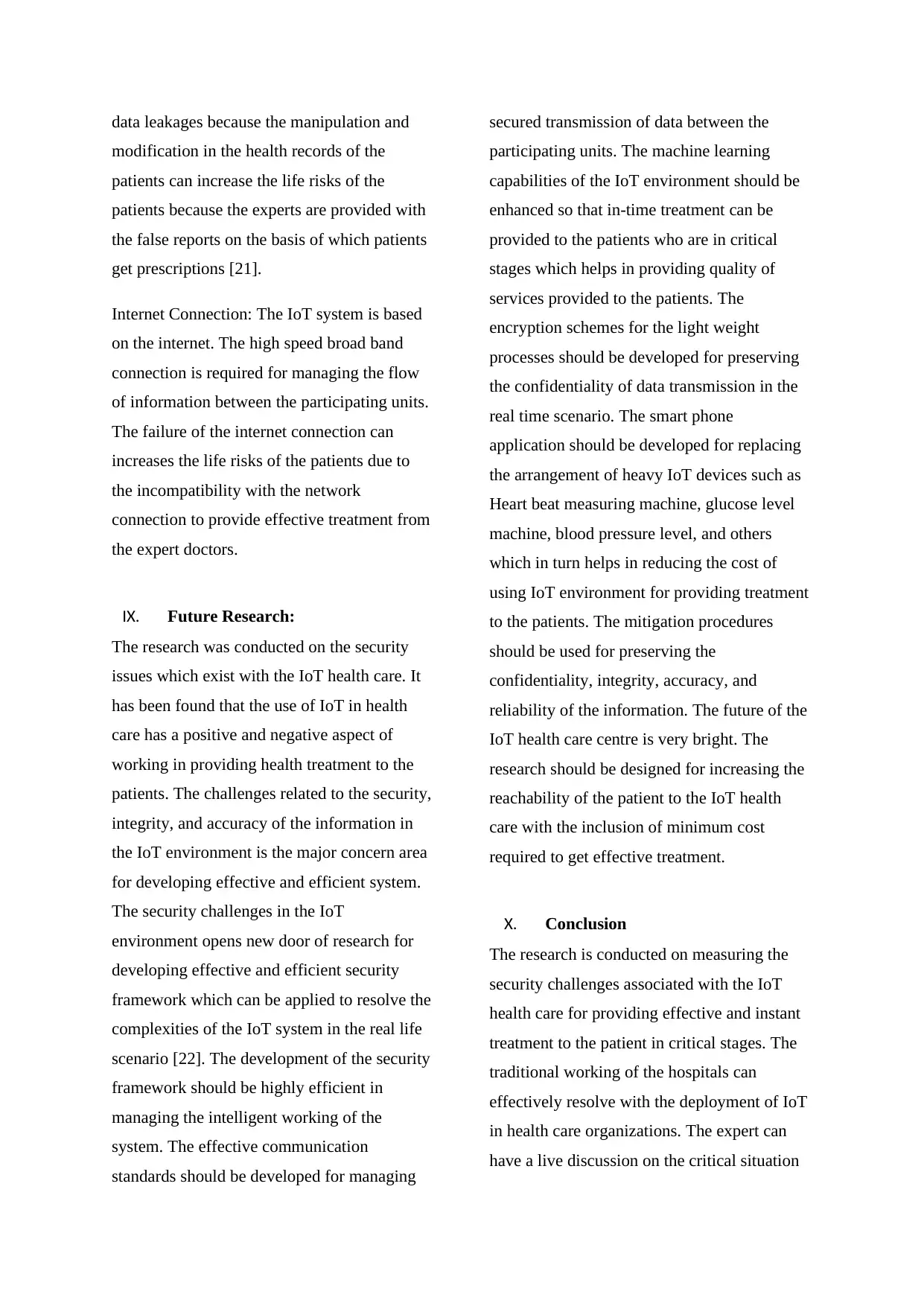
data leakages because the manipulation and
modification in the health records of the
patients can increase the life risks of the
patients because the experts are provided with
the false reports on the basis of which patients
get prescriptions [21].
Internet Connection: The IoT system is based
on the internet. The high speed broad band
connection is required for managing the flow
of information between the participating units.
The failure of the internet connection can
increases the life risks of the patients due to
the incompatibility with the network
connection to provide effective treatment from
the expert doctors.
IX. Future Research:
The research was conducted on the security
issues which exist with the IoT health care. It
has been found that the use of IoT in health
care has a positive and negative aspect of
working in providing health treatment to the
patients. The challenges related to the security,
integrity, and accuracy of the information in
the IoT environment is the major concern area
for developing effective and efficient system.
The security challenges in the IoT
environment opens new door of research for
developing effective and efficient security
framework which can be applied to resolve the
complexities of the IoT system in the real life
scenario [22]. The development of the security
framework should be highly efficient in
managing the intelligent working of the
system. The effective communication
standards should be developed for managing
secured transmission of data between the
participating units. The machine learning
capabilities of the IoT environment should be
enhanced so that in-time treatment can be
provided to the patients who are in critical
stages which helps in providing quality of
services provided to the patients. The
encryption schemes for the light weight
processes should be developed for preserving
the confidentiality of data transmission in the
real time scenario. The smart phone
application should be developed for replacing
the arrangement of heavy IoT devices such as
Heart beat measuring machine, glucose level
machine, blood pressure level, and others
which in turn helps in reducing the cost of
using IoT environment for providing treatment
to the patients. The mitigation procedures
should be used for preserving the
confidentiality, integrity, accuracy, and
reliability of the information. The future of the
IoT health care centre is very bright. The
research should be designed for increasing the
reachability of the patient to the IoT health
care with the inclusion of minimum cost
required to get effective treatment.
X. Conclusion
The research is conducted on measuring the
security challenges associated with the IoT
health care for providing effective and instant
treatment to the patient in critical stages. The
traditional working of the hospitals can
effectively resolve with the deployment of IoT
in health care organizations. The expert can
have a live discussion on the critical situation
modification in the health records of the
patients can increase the life risks of the
patients because the experts are provided with
the false reports on the basis of which patients
get prescriptions [21].
Internet Connection: The IoT system is based
on the internet. The high speed broad band
connection is required for managing the flow
of information between the participating units.
The failure of the internet connection can
increases the life risks of the patients due to
the incompatibility with the network
connection to provide effective treatment from
the expert doctors.
IX. Future Research:
The research was conducted on the security
issues which exist with the IoT health care. It
has been found that the use of IoT in health
care has a positive and negative aspect of
working in providing health treatment to the
patients. The challenges related to the security,
integrity, and accuracy of the information in
the IoT environment is the major concern area
for developing effective and efficient system.
The security challenges in the IoT
environment opens new door of research for
developing effective and efficient security
framework which can be applied to resolve the
complexities of the IoT system in the real life
scenario [22]. The development of the security
framework should be highly efficient in
managing the intelligent working of the
system. The effective communication
standards should be developed for managing
secured transmission of data between the
participating units. The machine learning
capabilities of the IoT environment should be
enhanced so that in-time treatment can be
provided to the patients who are in critical
stages which helps in providing quality of
services provided to the patients. The
encryption schemes for the light weight
processes should be developed for preserving
the confidentiality of data transmission in the
real time scenario. The smart phone
application should be developed for replacing
the arrangement of heavy IoT devices such as
Heart beat measuring machine, glucose level
machine, blood pressure level, and others
which in turn helps in reducing the cost of
using IoT environment for providing treatment
to the patients. The mitigation procedures
should be used for preserving the
confidentiality, integrity, accuracy, and
reliability of the information. The future of the
IoT health care centre is very bright. The
research should be designed for increasing the
reachability of the patient to the IoT health
care with the inclusion of minimum cost
required to get effective treatment.
X. Conclusion
The research is conducted on measuring the
security challenges associated with the IoT
health care for providing effective and instant
treatment to the patient in critical stages. The
traditional working of the hospitals can
effectively resolve with the deployment of IoT
in health care organizations. The expert can
have a live discussion on the critical situation
Secure Best Marks with AI Grader
Need help grading? Try our AI Grader for instant feedback on your assignments.

of the patient to provide instant treatment to
resolve the complexity of the life risks. The
outcome of the IOT health care can be
measured on the basis of preserving the life of
the patient. The patients are provided with the
real time treatment in the home care of their
houses. The patients are monitored by multiple
experts at a time to give effective treatment.
The advancement in the IoT health care is
associated with advanced security issues
which can adversely affect the functioning of
the system. The big data management system
is the emerging requirement of the health care
because the increasing number of customers
who are getting associated with IoT health
care result in excessive burden of storing big
data generated from the patient health records,
check-up reports, and previous prescription of
the doctors. It is the major challenge to store
the data of the patient systematically on the
network. The monitoring and control policies
should be prepared for designing of the IoT
architecture so as to reduce the complexities
and challenges which are occurred in the
efficient working of the IoT solution. The
proper consideration should be given to the
security policies. The cryptographic
procedures and encryption methodologies
should be used for preserving the online data
of the patient. The IoT health care
environment works on the fundamentals of
accuracy program. The security procedures
should be laid down for preserving the loss of
data from data leakages because the
manipulation and modification in the health
records of the patients can increase the life
risks of the patients because the experts are
provided with the false reports on the basis of
which patients get prescriptions. It is
advantageous for using the IoT in health care
organization because it is capable of providing
effective treatment to the individual patient
from multi-user expert who are geographically
dispersed.
XI. References:
[1] M. Bhabad, and S. Bagade, Internet of
things, security issues and
countermeasures. 2010.
[2] J. Illegems, The internet of things in health
care. 2016
[3] R. Islam, D. Kwak, M. Kabir, and K.
Kwak, The internet of things for
health care: A comprehensive survey.
2015.
[4] Z. Kalarthi, A Review paper on smart
health care system using Internet of
things. International Journal of
research in engineering and
technology, 12(5), 2013.
[5] A.Kulkarni, and S. Sathe, Healthcare
application of the internet of things: A
Review. International Journal of
computer science and information
technologies, 5(5). 2014.
[6] R. Kunwar, A survey report on security
and challenges in internet of things.
2016
resolve the complexity of the life risks. The
outcome of the IOT health care can be
measured on the basis of preserving the life of
the patient. The patients are provided with the
real time treatment in the home care of their
houses. The patients are monitored by multiple
experts at a time to give effective treatment.
The advancement in the IoT health care is
associated with advanced security issues
which can adversely affect the functioning of
the system. The big data management system
is the emerging requirement of the health care
because the increasing number of customers
who are getting associated with IoT health
care result in excessive burden of storing big
data generated from the patient health records,
check-up reports, and previous prescription of
the doctors. It is the major challenge to store
the data of the patient systematically on the
network. The monitoring and control policies
should be prepared for designing of the IoT
architecture so as to reduce the complexities
and challenges which are occurred in the
efficient working of the IoT solution. The
proper consideration should be given to the
security policies. The cryptographic
procedures and encryption methodologies
should be used for preserving the online data
of the patient. The IoT health care
environment works on the fundamentals of
accuracy program. The security procedures
should be laid down for preserving the loss of
data from data leakages because the
manipulation and modification in the health
records of the patients can increase the life
risks of the patients because the experts are
provided with the false reports on the basis of
which patients get prescriptions. It is
advantageous for using the IoT in health care
organization because it is capable of providing
effective treatment to the individual patient
from multi-user expert who are geographically
dispersed.
XI. References:
[1] M. Bhabad, and S. Bagade, Internet of
things, security issues and
countermeasures. 2010.
[2] J. Illegems, The internet of things in health
care. 2016
[3] R. Islam, D. Kwak, M. Kabir, and K.
Kwak, The internet of things for
health care: A comprehensive survey.
2015.
[4] Z. Kalarthi, A Review paper on smart
health care system using Internet of
things. International Journal of
research in engineering and
technology, 12(5), 2013.
[5] A.Kulkarni, and S. Sathe, Healthcare
application of the internet of things: A
Review. International Journal of
computer science and information
technologies, 5(5). 2014.
[6] R. Kunwar, A survey report on security
and challenges in internet of things.
2016
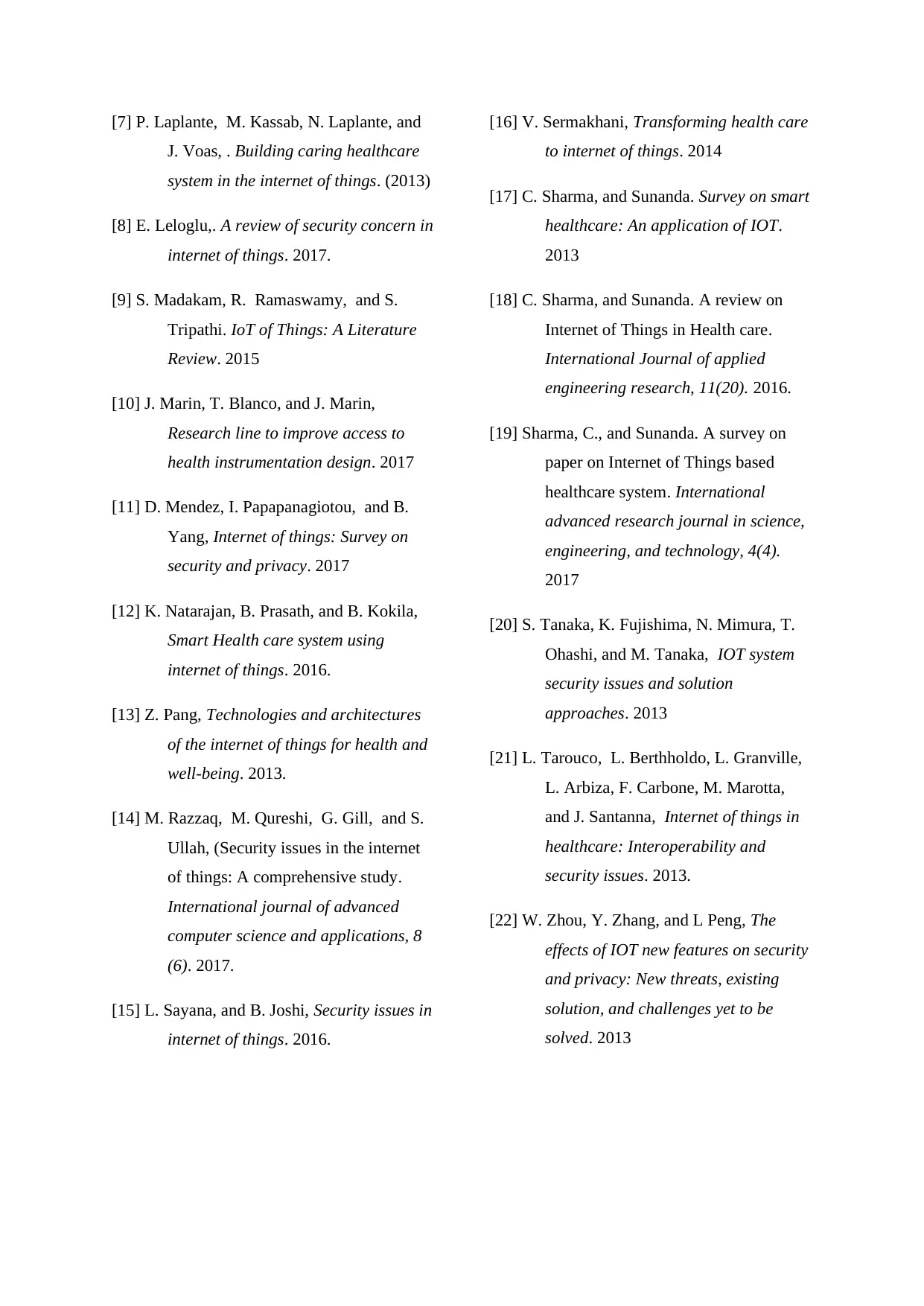
[7] P. Laplante, M. Kassab, N. Laplante, and
J. Voas, . Building caring healthcare
system in the internet of things. (2013)
[8] E. Leloglu,. A review of security concern in
internet of things. 2017.
[9] S. Madakam, R. Ramaswamy, and S.
Tripathi. IoT of Things: A Literature
Review. 2015
[10] J. Marin, T. Blanco, and J. Marin,
Research line to improve access to
health instrumentation design. 2017
[11] D. Mendez, I. Papapanagiotou, and B.
Yang, Internet of things: Survey on
security and privacy. 2017
[12] K. Natarajan, B. Prasath, and B. Kokila,
Smart Health care system using
internet of things. 2016.
[13] Z. Pang, Technologies and architectures
of the internet of things for health and
well-being. 2013.
[14] M. Razzaq, M. Qureshi, G. Gill, and S.
Ullah, (Security issues in the internet
of things: A comprehensive study.
International journal of advanced
computer science and applications, 8
(6). 2017.
[15] L. Sayana, and B. Joshi, Security issues in
internet of things. 2016.
[16] V. Sermakhani, Transforming health care
to internet of things. 2014
[17] C. Sharma, and Sunanda. Survey on smart
healthcare: An application of IOT.
2013
[18] C. Sharma, and Sunanda. A review on
Internet of Things in Health care.
International Journal of applied
engineering research, 11(20). 2016.
[19] Sharma, C., and Sunanda. A survey on
paper on Internet of Things based
healthcare system. International
advanced research journal in science,
engineering, and technology, 4(4).
2017
[20] S. Tanaka, K. Fujishima, N. Mimura, T.
Ohashi, and M. Tanaka, IOT system
security issues and solution
approaches. 2013
[21] L. Tarouco, L. Berthholdo, L. Granville,
L. Arbiza, F. Carbone, M. Marotta,
and J. Santanna, Internet of things in
healthcare: Interoperability and
security issues. 2013.
[22] W. Zhou, Y. Zhang, and L Peng, The
effects of IOT new features on security
and privacy: New threats, existing
solution, and challenges yet to be
solved. 2013
J. Voas, . Building caring healthcare
system in the internet of things. (2013)
[8] E. Leloglu,. A review of security concern in
internet of things. 2017.
[9] S. Madakam, R. Ramaswamy, and S.
Tripathi. IoT of Things: A Literature
Review. 2015
[10] J. Marin, T. Blanco, and J. Marin,
Research line to improve access to
health instrumentation design. 2017
[11] D. Mendez, I. Papapanagiotou, and B.
Yang, Internet of things: Survey on
security and privacy. 2017
[12] K. Natarajan, B. Prasath, and B. Kokila,
Smart Health care system using
internet of things. 2016.
[13] Z. Pang, Technologies and architectures
of the internet of things for health and
well-being. 2013.
[14] M. Razzaq, M. Qureshi, G. Gill, and S.
Ullah, (Security issues in the internet
of things: A comprehensive study.
International journal of advanced
computer science and applications, 8
(6). 2017.
[15] L. Sayana, and B. Joshi, Security issues in
internet of things. 2016.
[16] V. Sermakhani, Transforming health care
to internet of things. 2014
[17] C. Sharma, and Sunanda. Survey on smart
healthcare: An application of IOT.
2013
[18] C. Sharma, and Sunanda. A review on
Internet of Things in Health care.
International Journal of applied
engineering research, 11(20). 2016.
[19] Sharma, C., and Sunanda. A survey on
paper on Internet of Things based
healthcare system. International
advanced research journal in science,
engineering, and technology, 4(4).
2017
[20] S. Tanaka, K. Fujishima, N. Mimura, T.
Ohashi, and M. Tanaka, IOT system
security issues and solution
approaches. 2013
[21] L. Tarouco, L. Berthholdo, L. Granville,
L. Arbiza, F. Carbone, M. Marotta,
and J. Santanna, Internet of things in
healthcare: Interoperability and
security issues. 2013.
[22] W. Zhou, Y. Zhang, and L Peng, The
effects of IOT new features on security
and privacy: New threats, existing
solution, and challenges yet to be
solved. 2013
1 out of 18
Related Documents
Your All-in-One AI-Powered Toolkit for Academic Success.
+13062052269
info@desklib.com
Available 24*7 on WhatsApp / Email
![[object Object]](/_next/static/media/star-bottom.7253800d.svg)
Unlock your academic potential
© 2024 | Zucol Services PVT LTD | All rights reserved.




